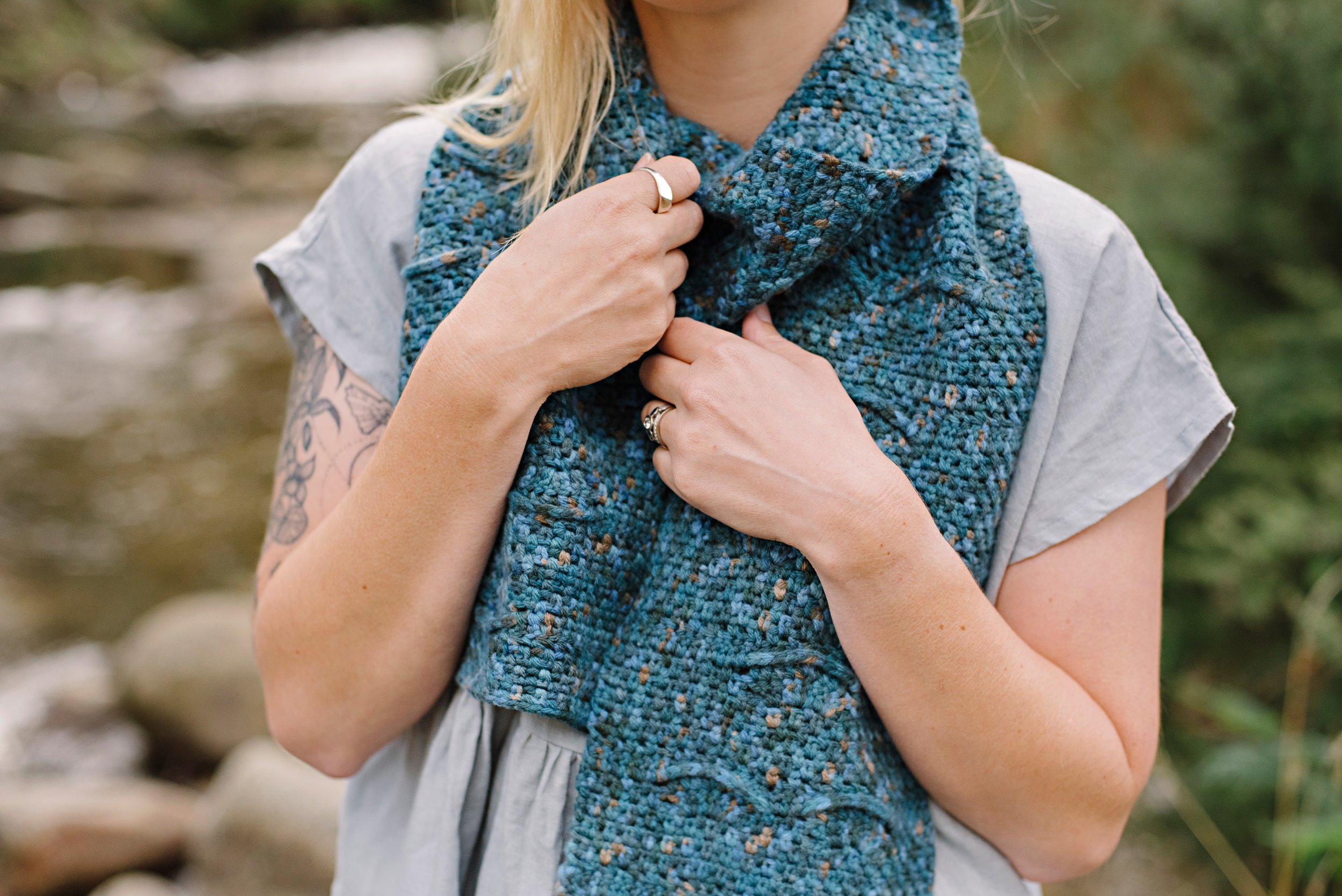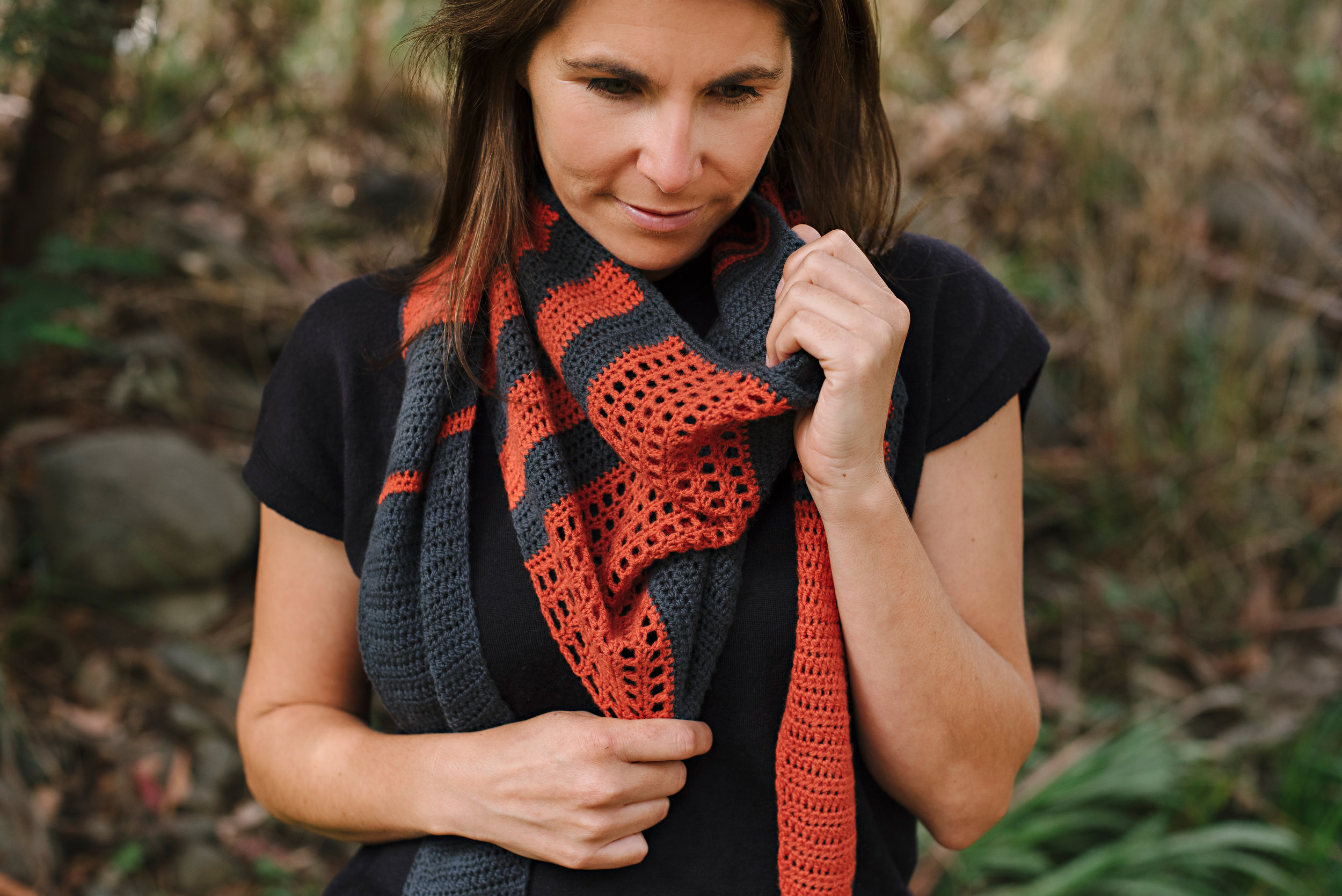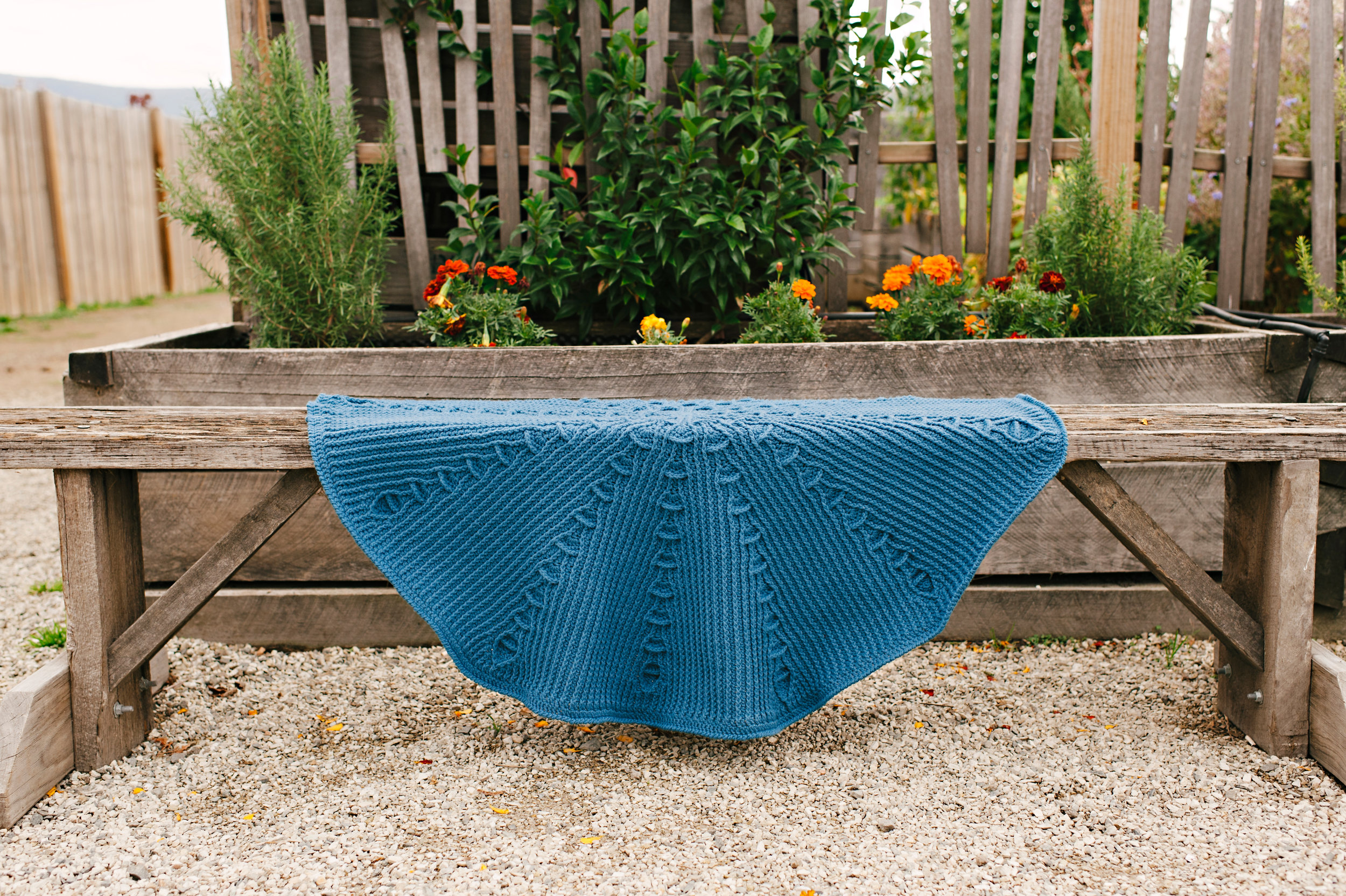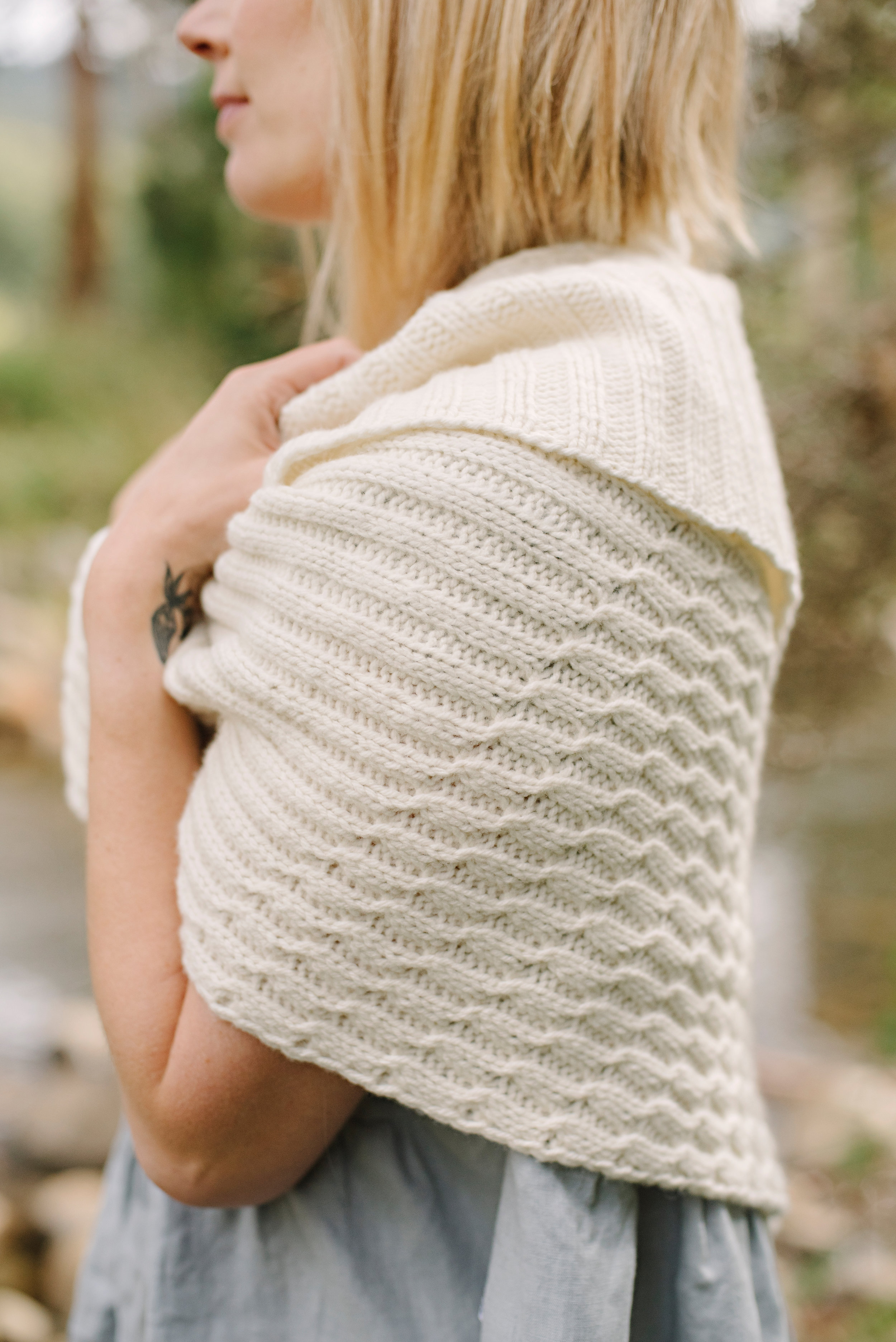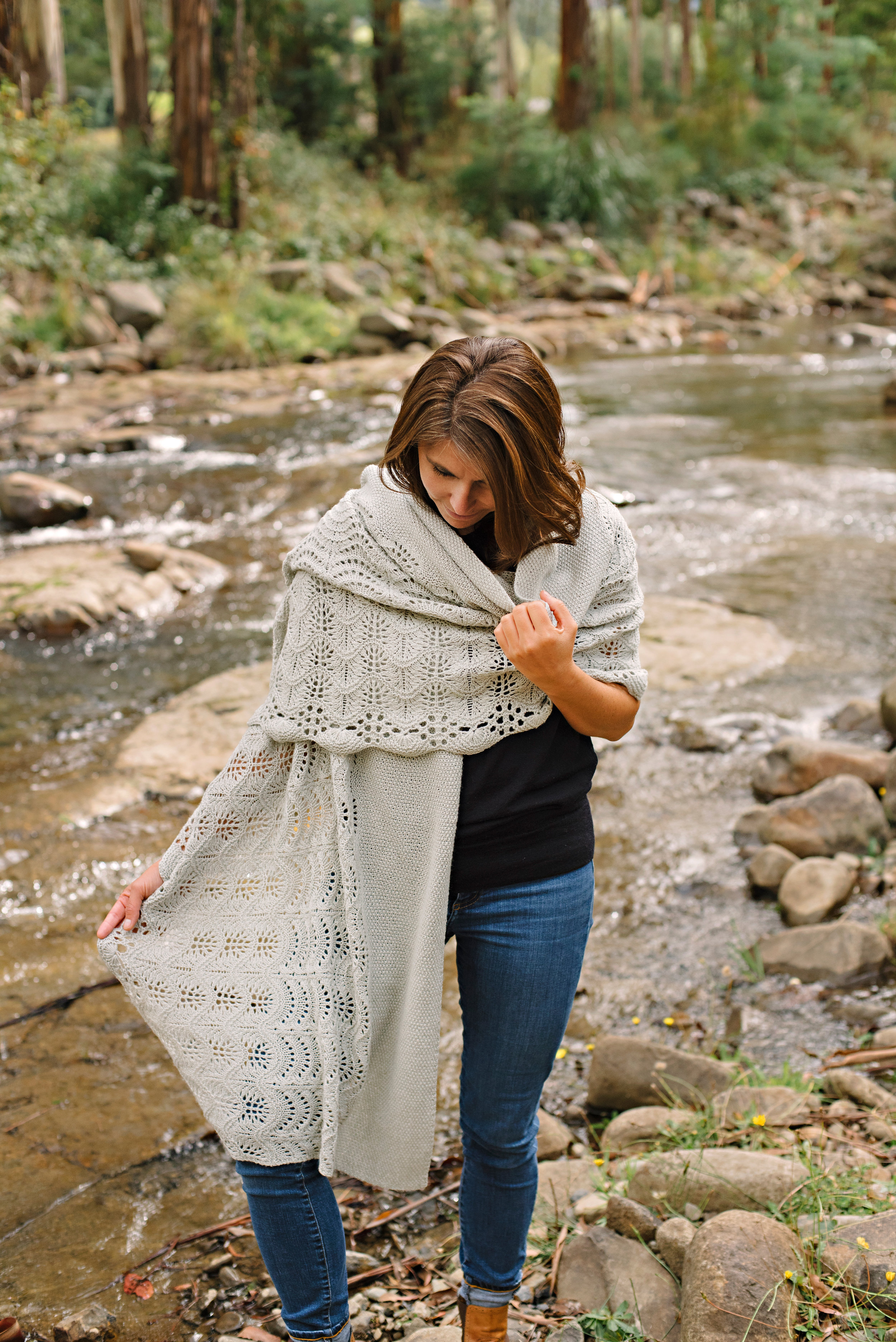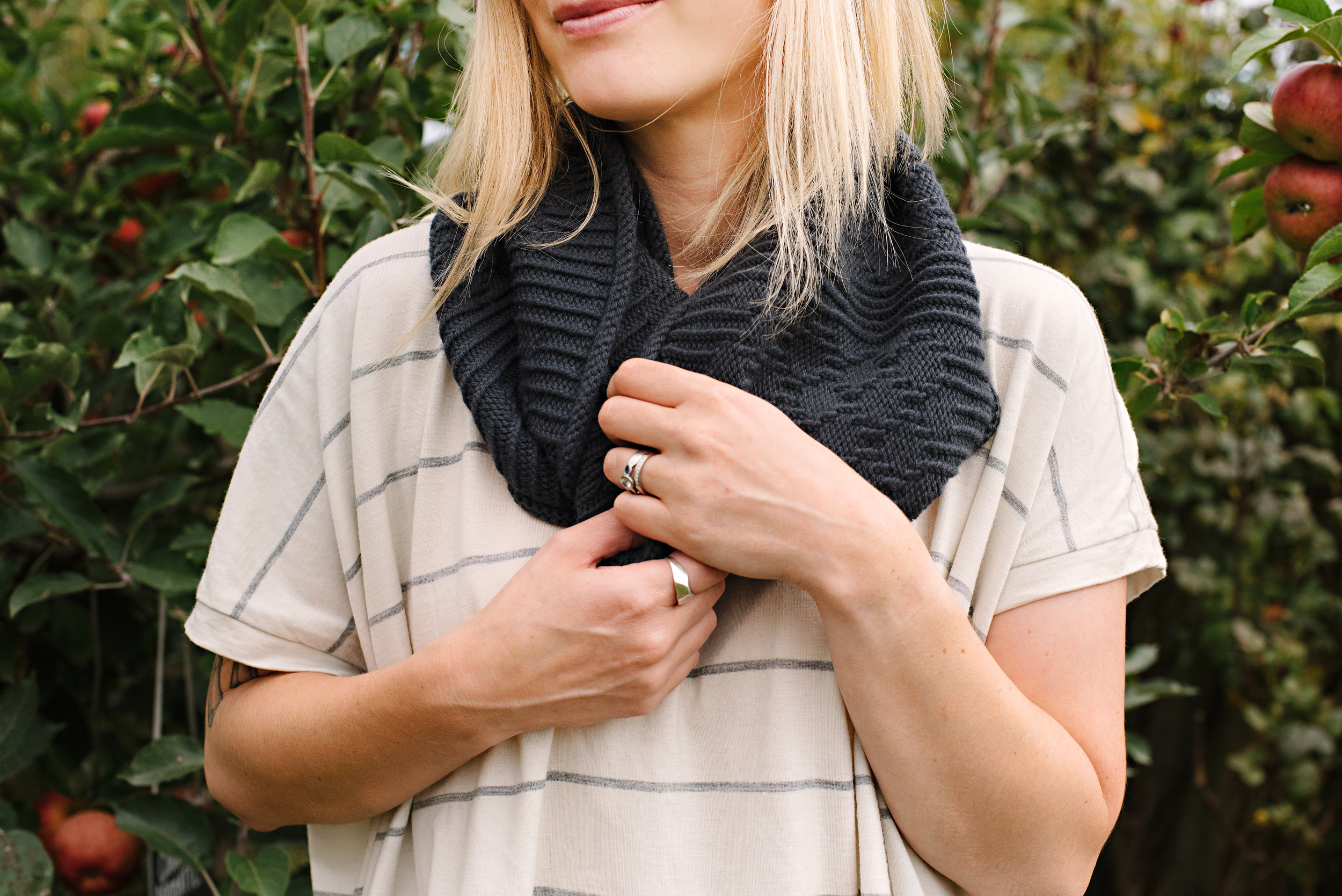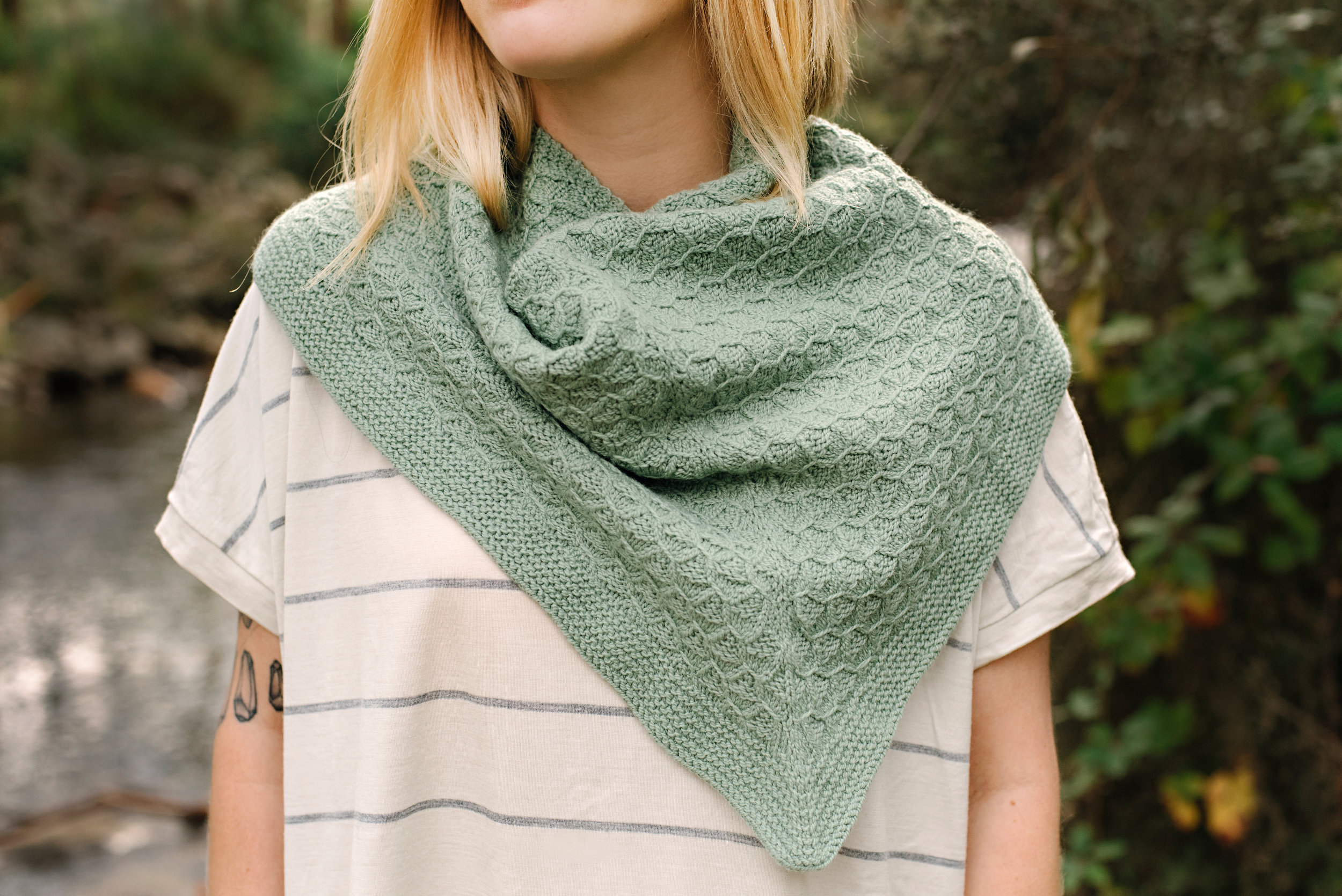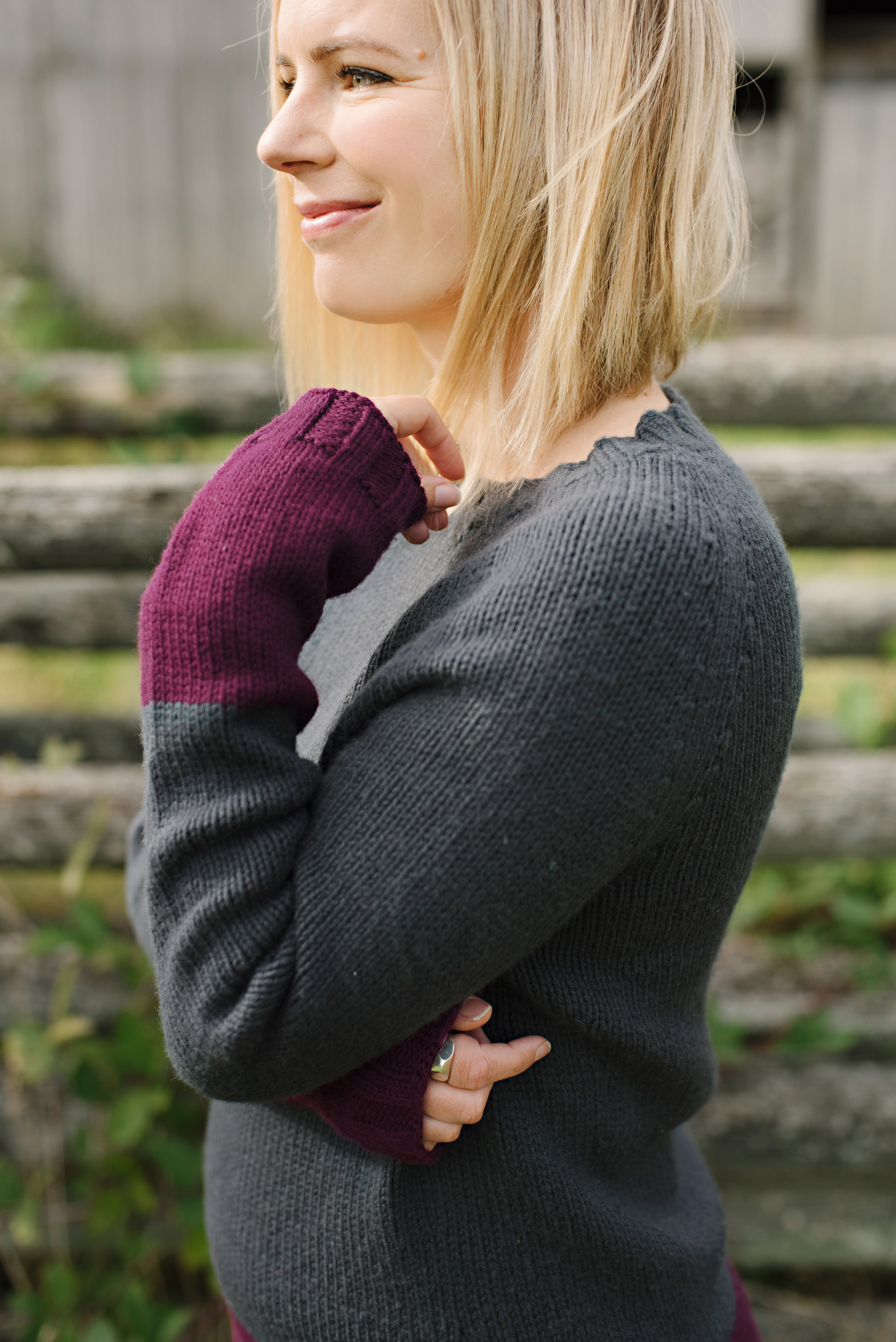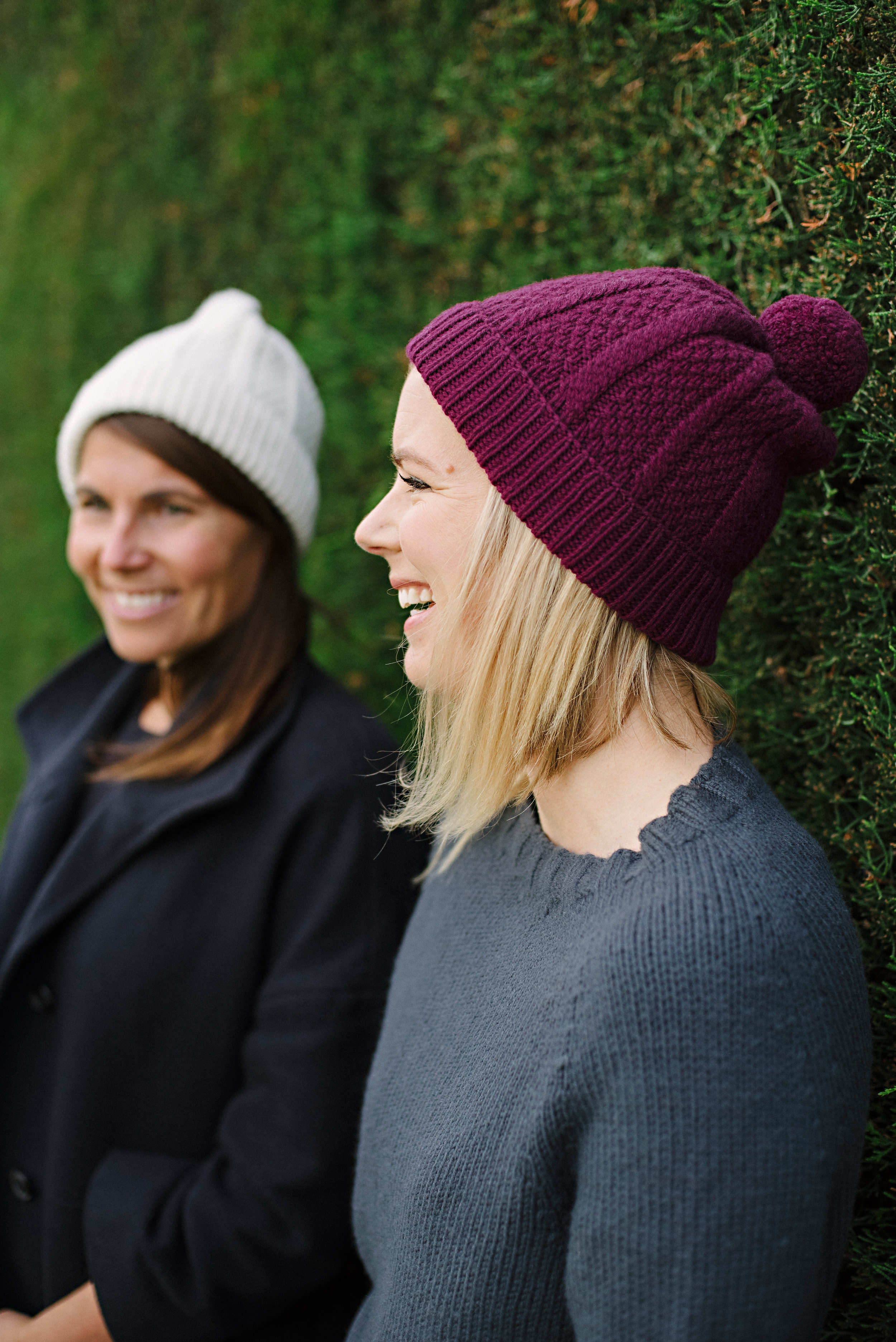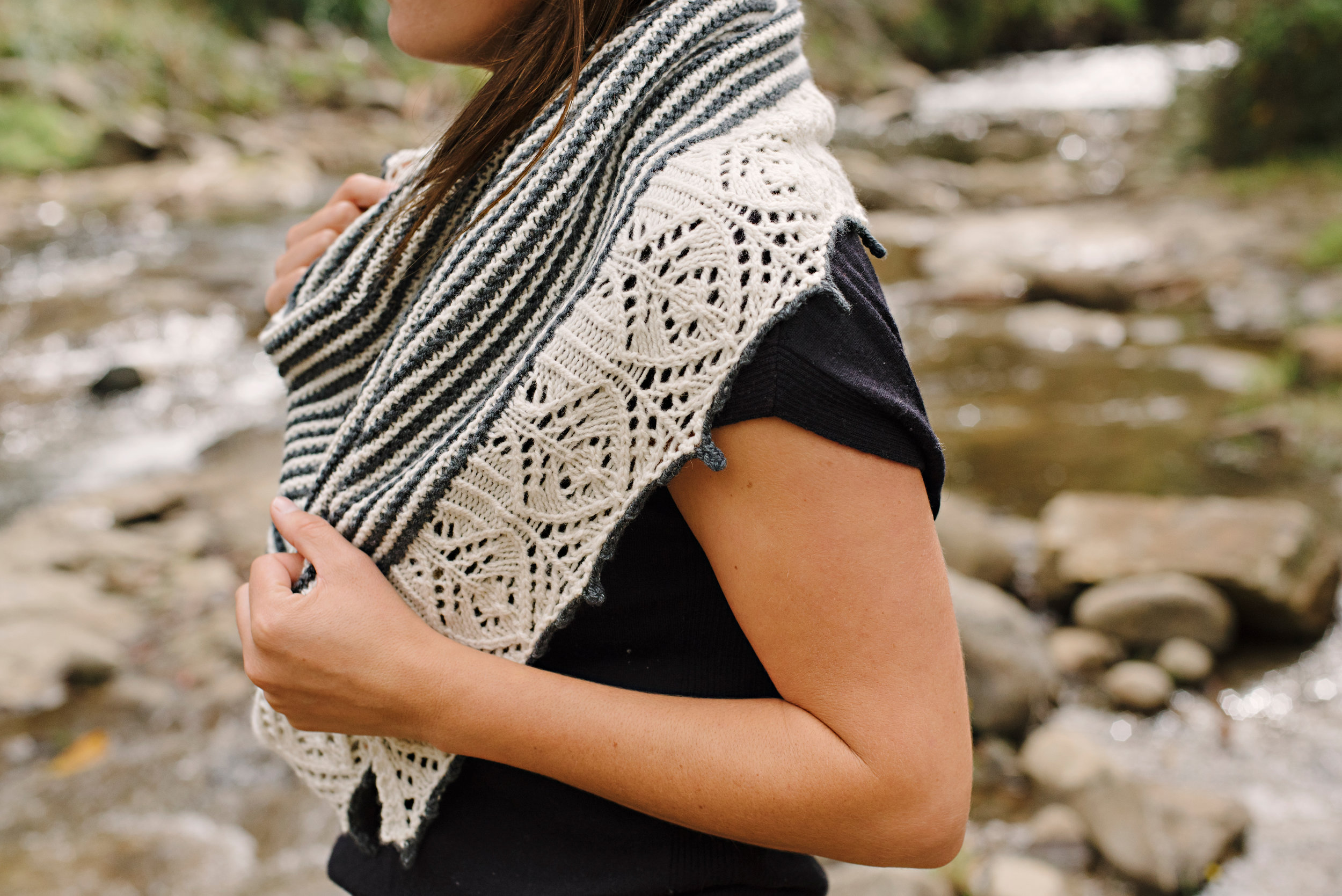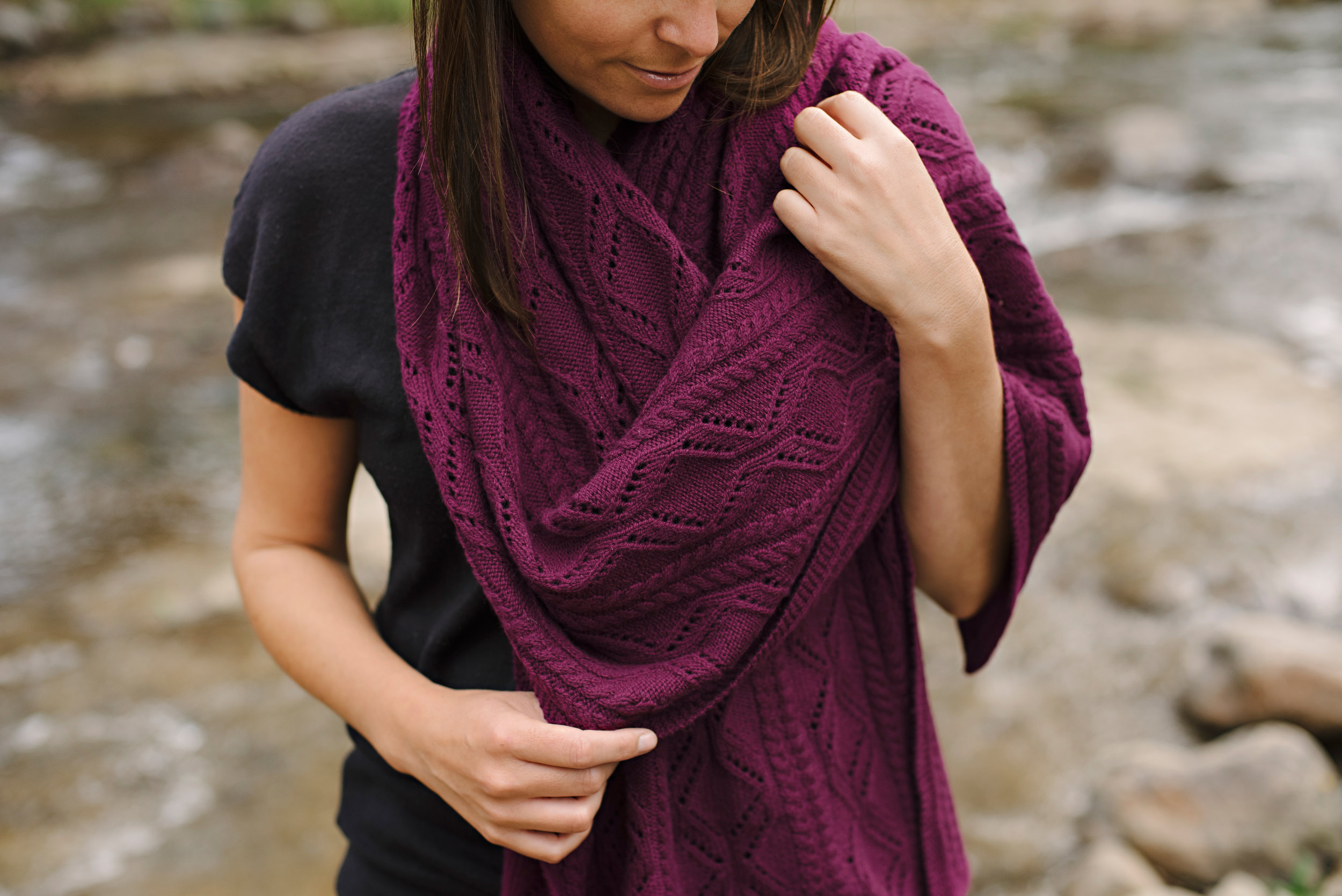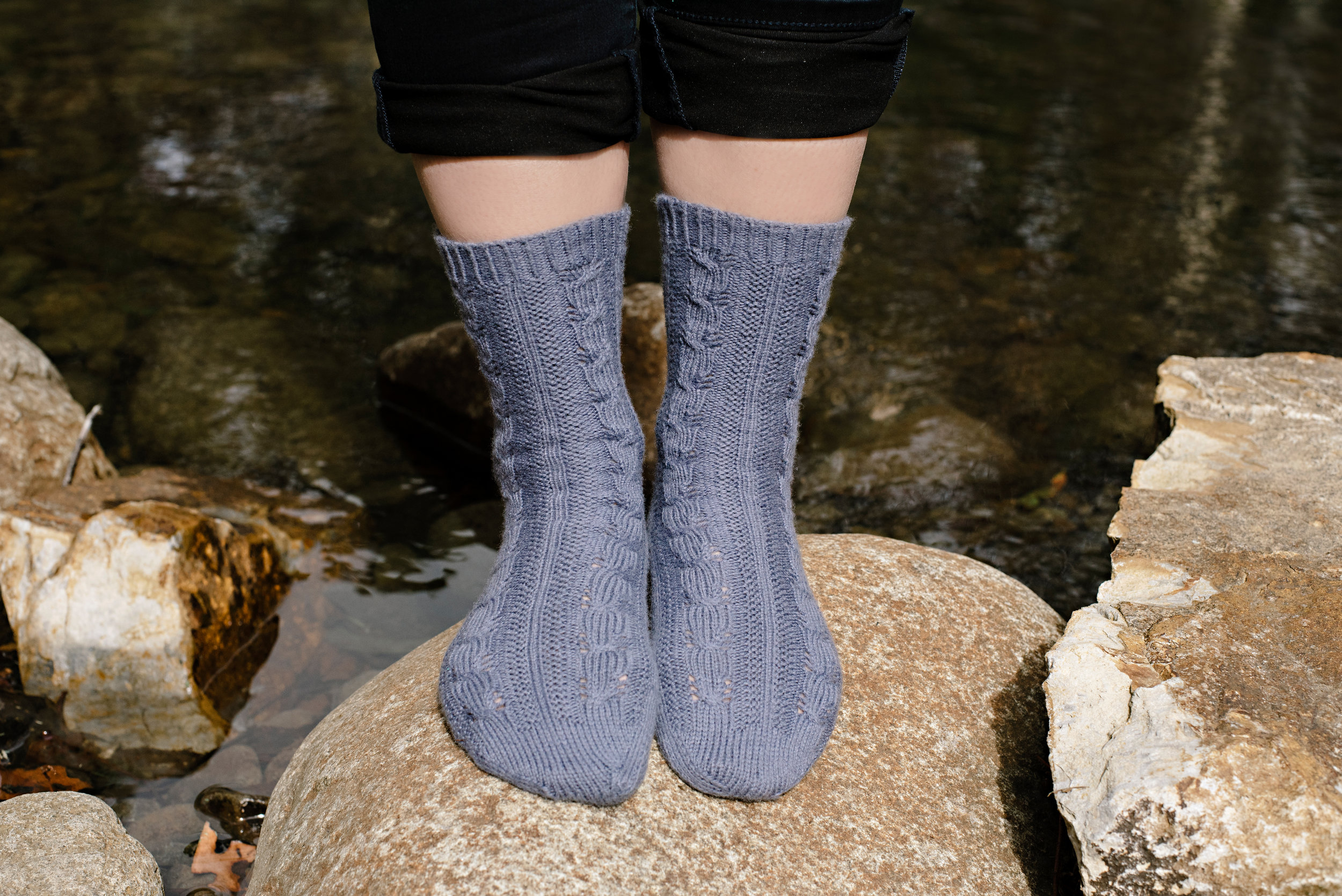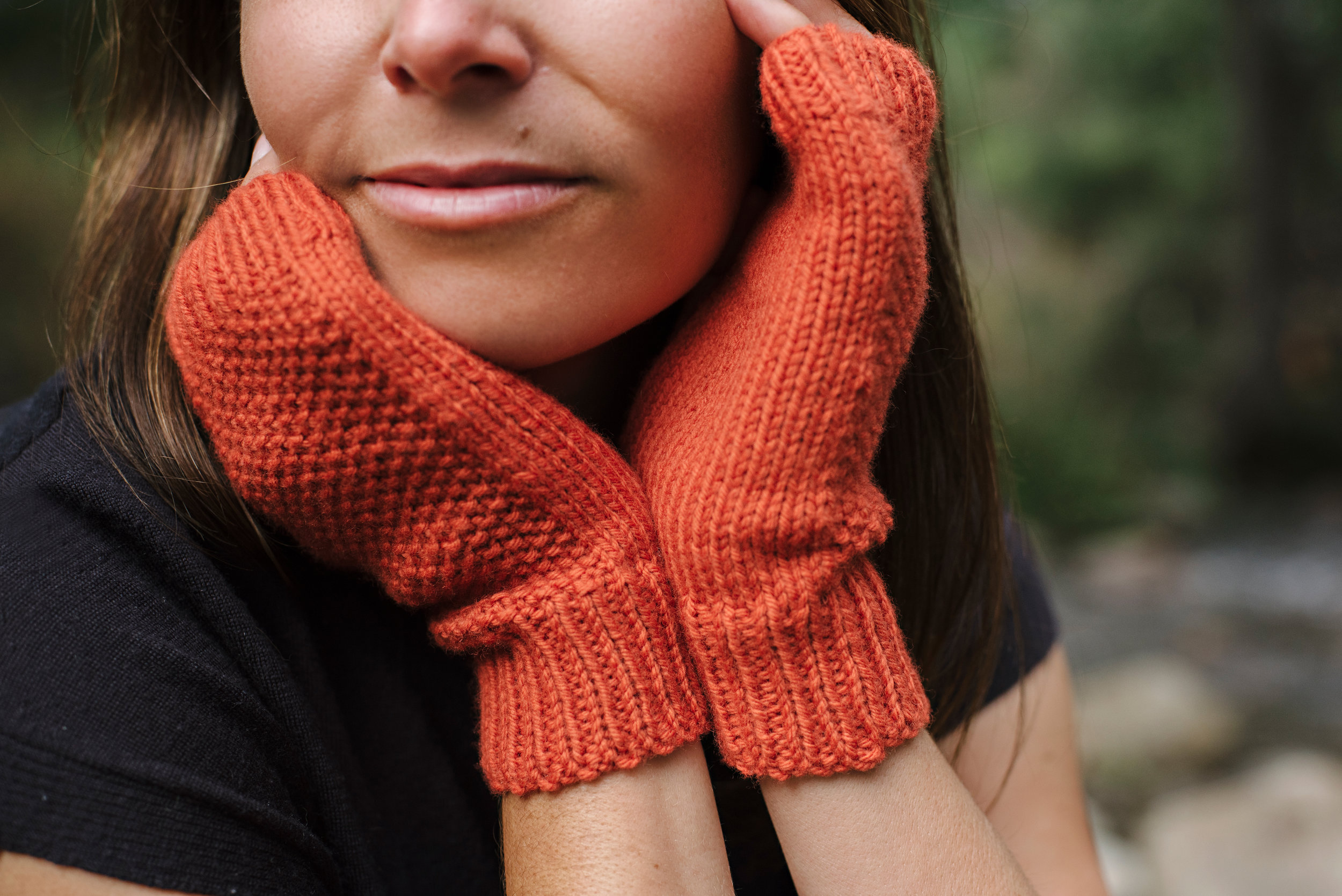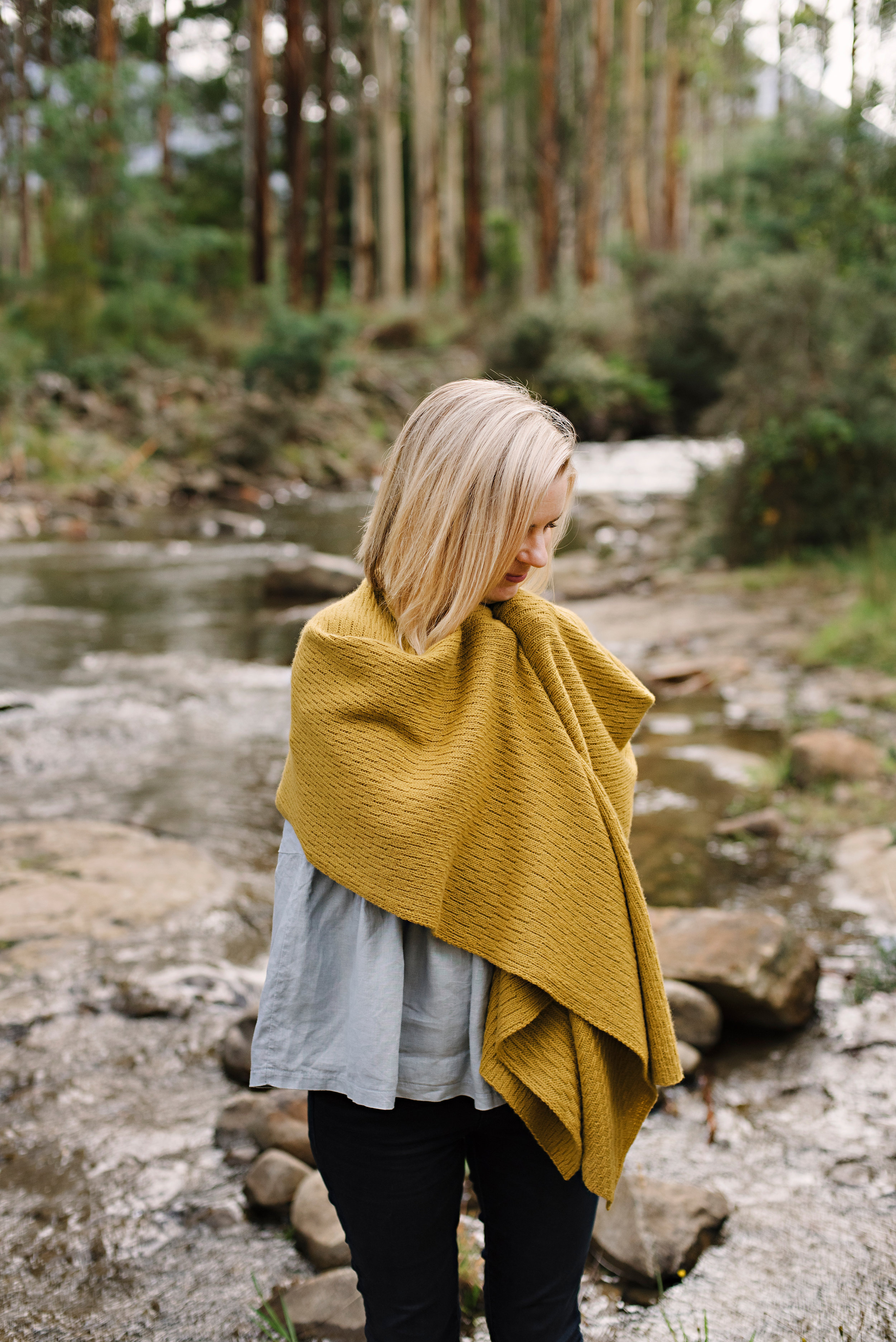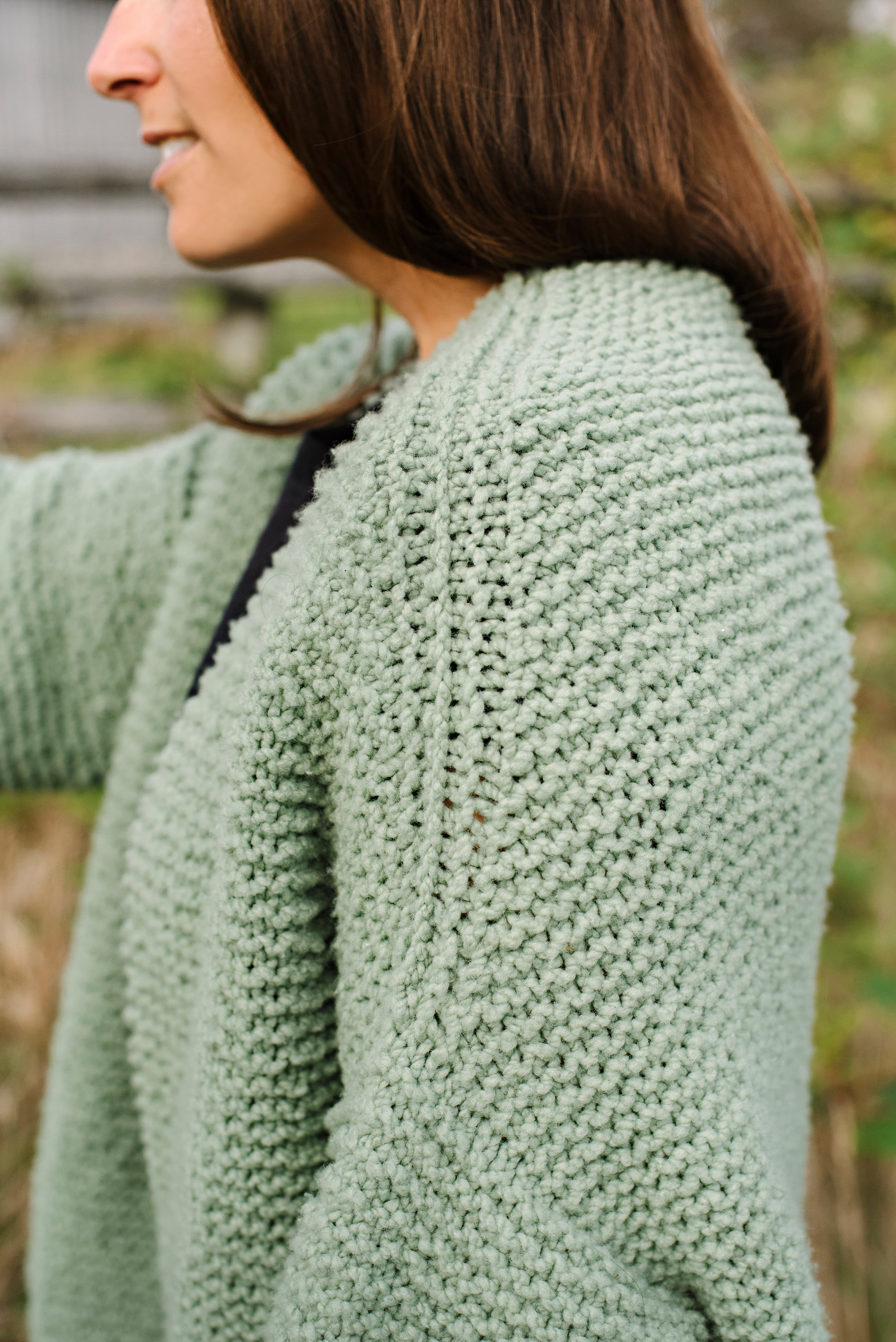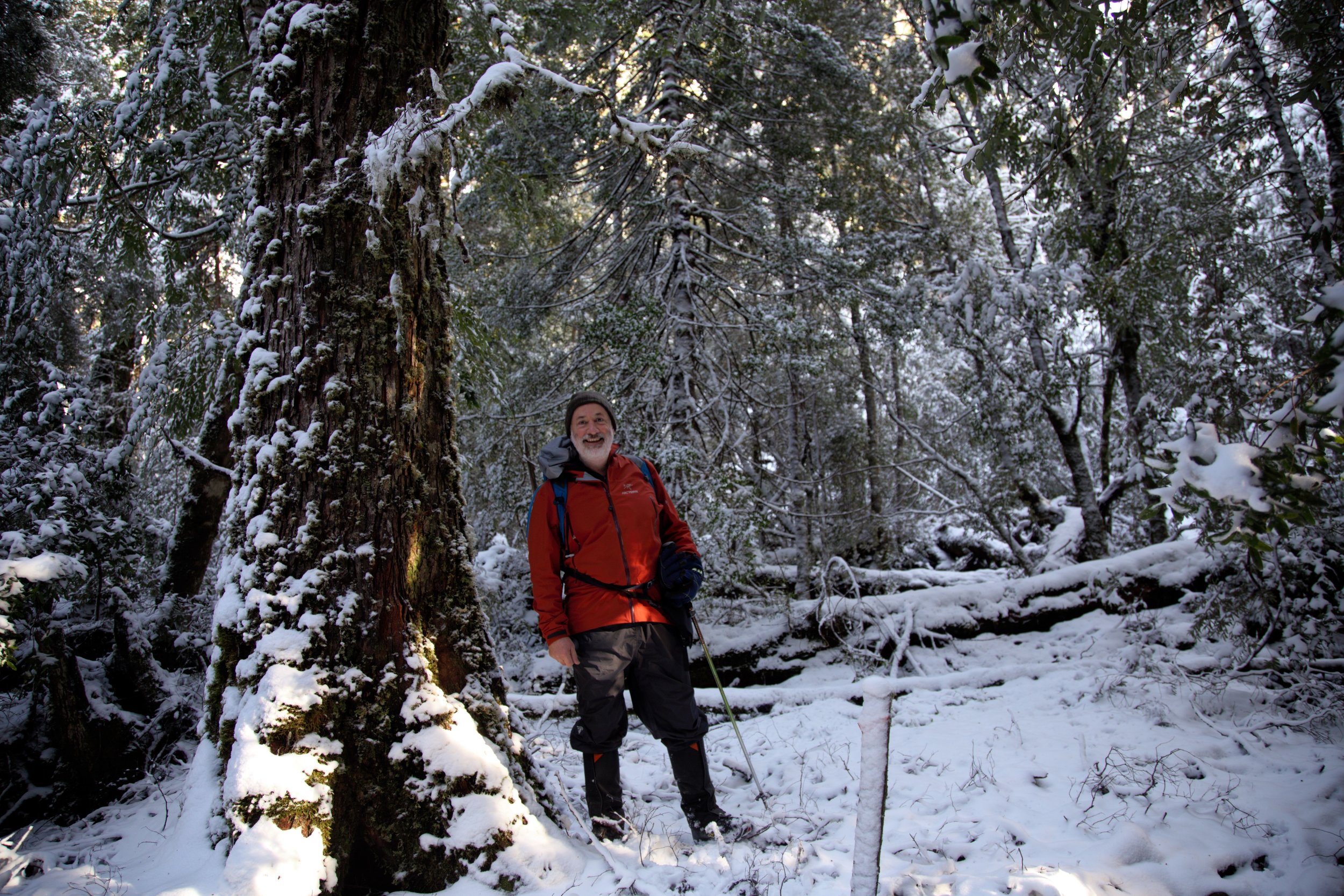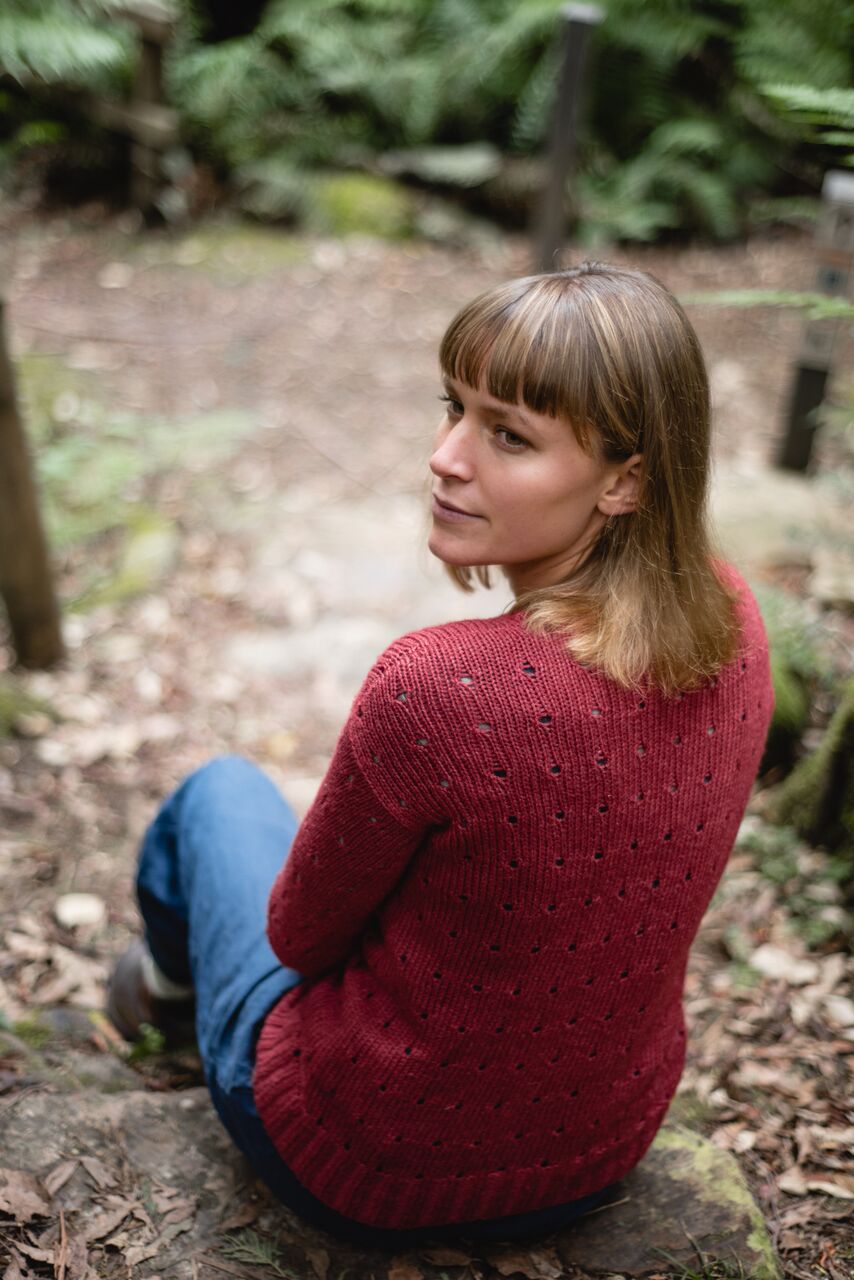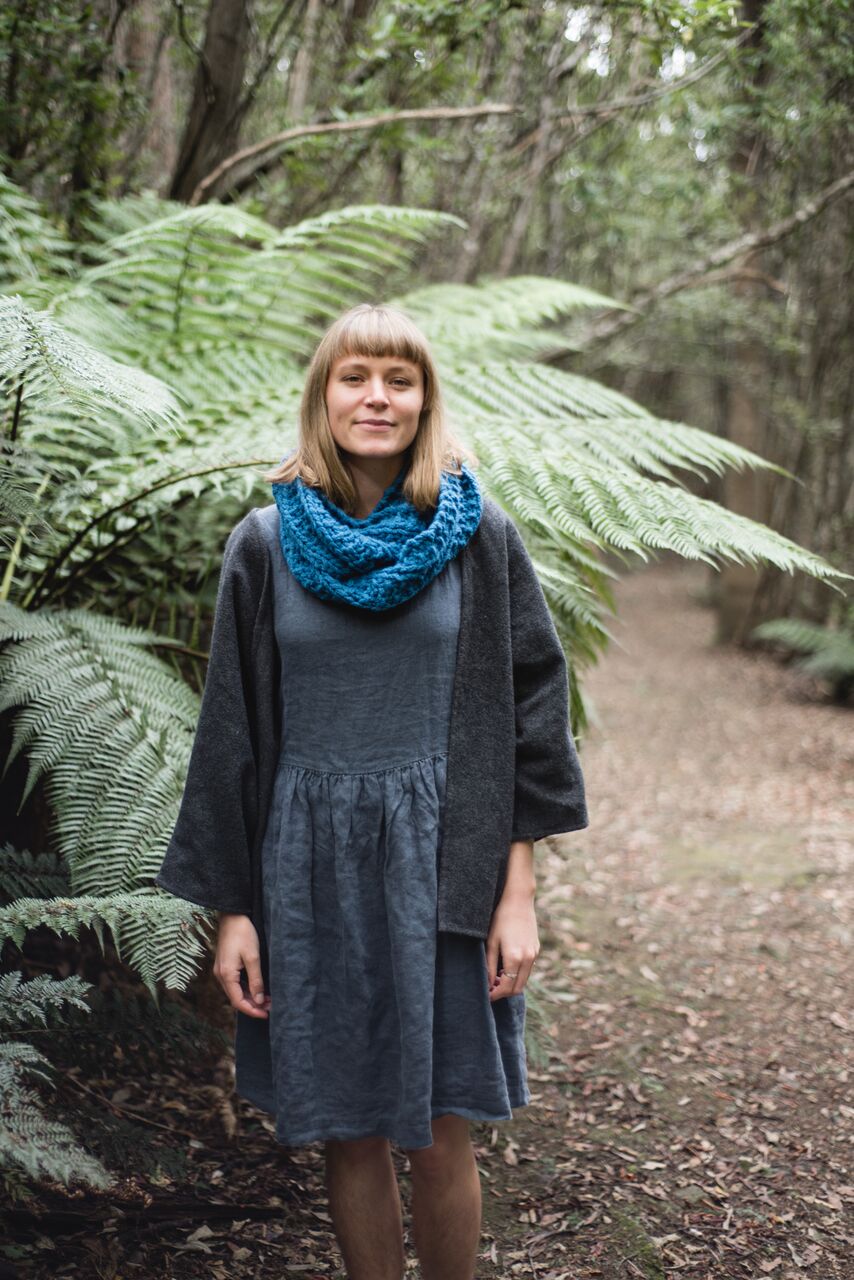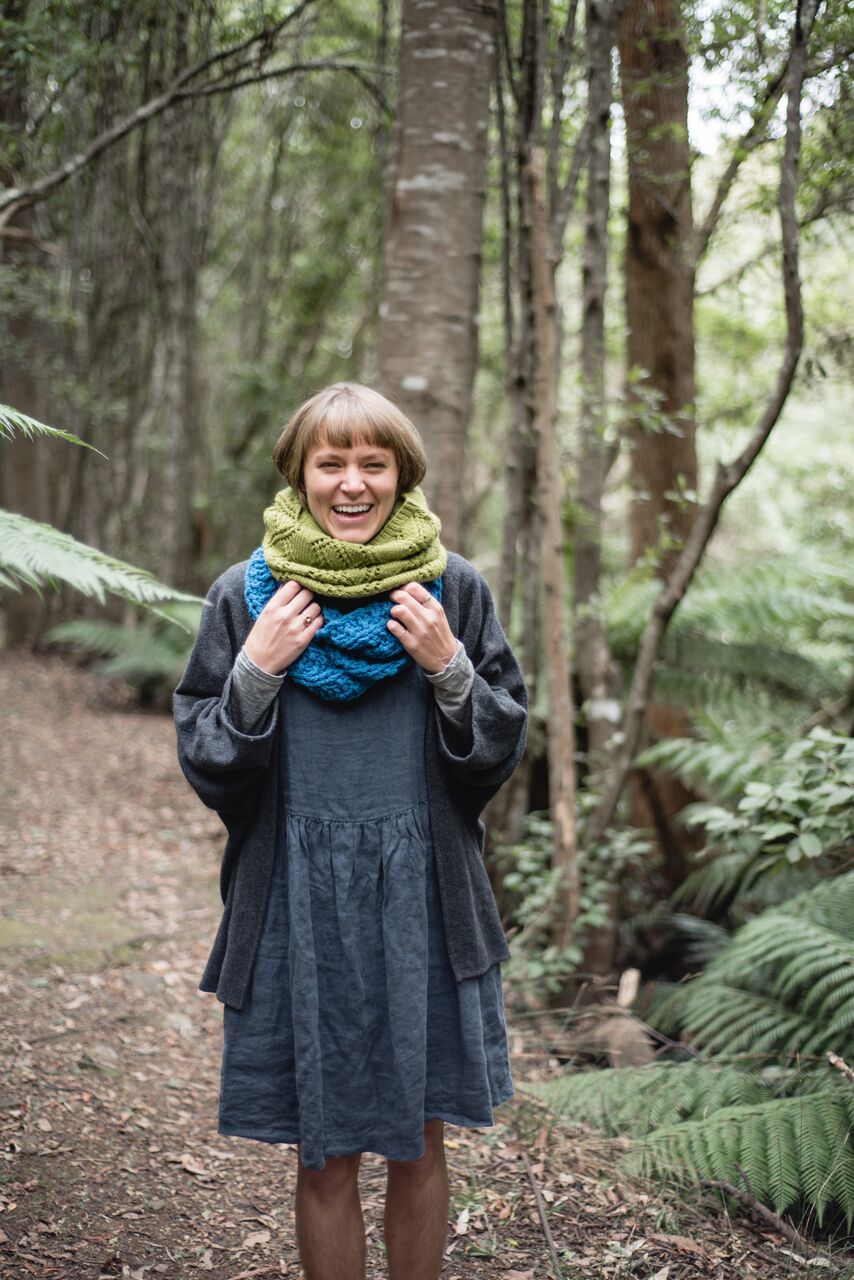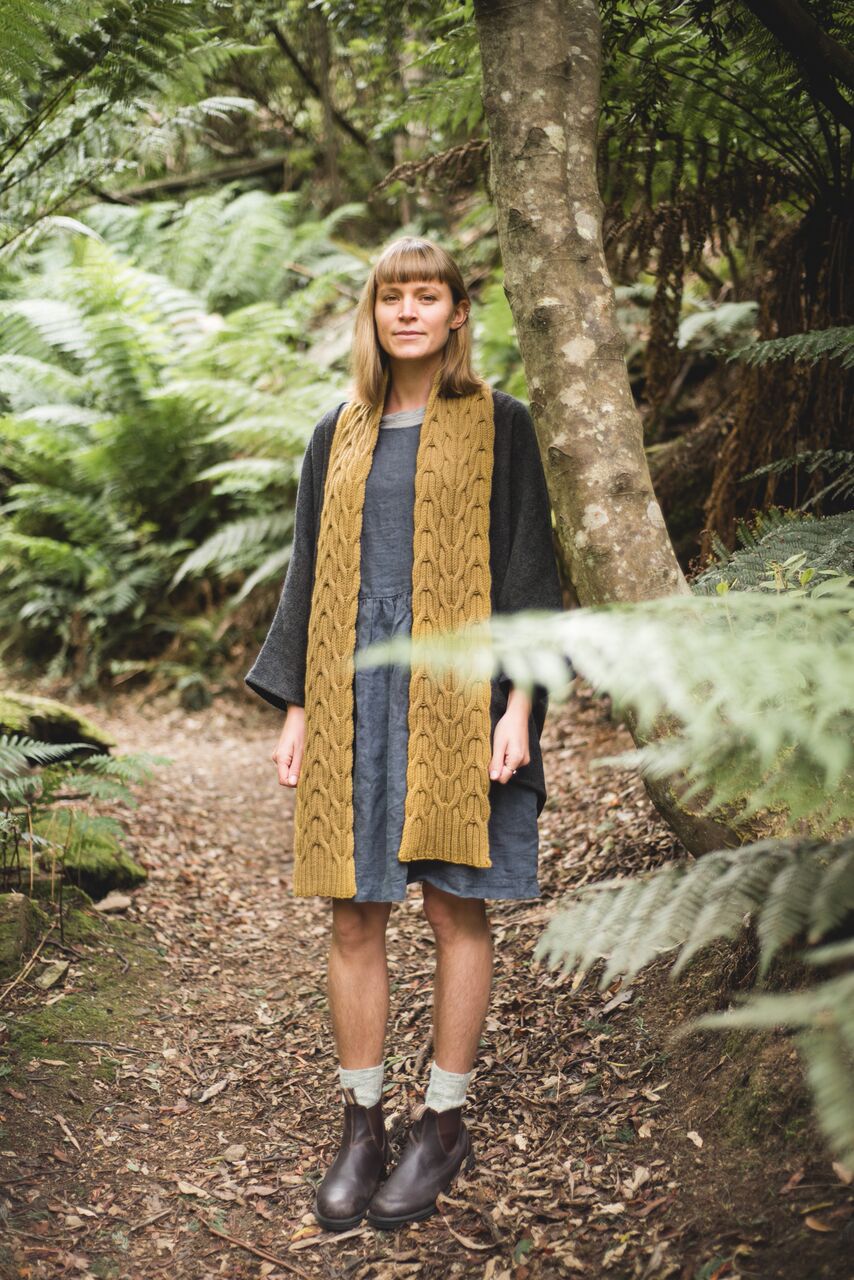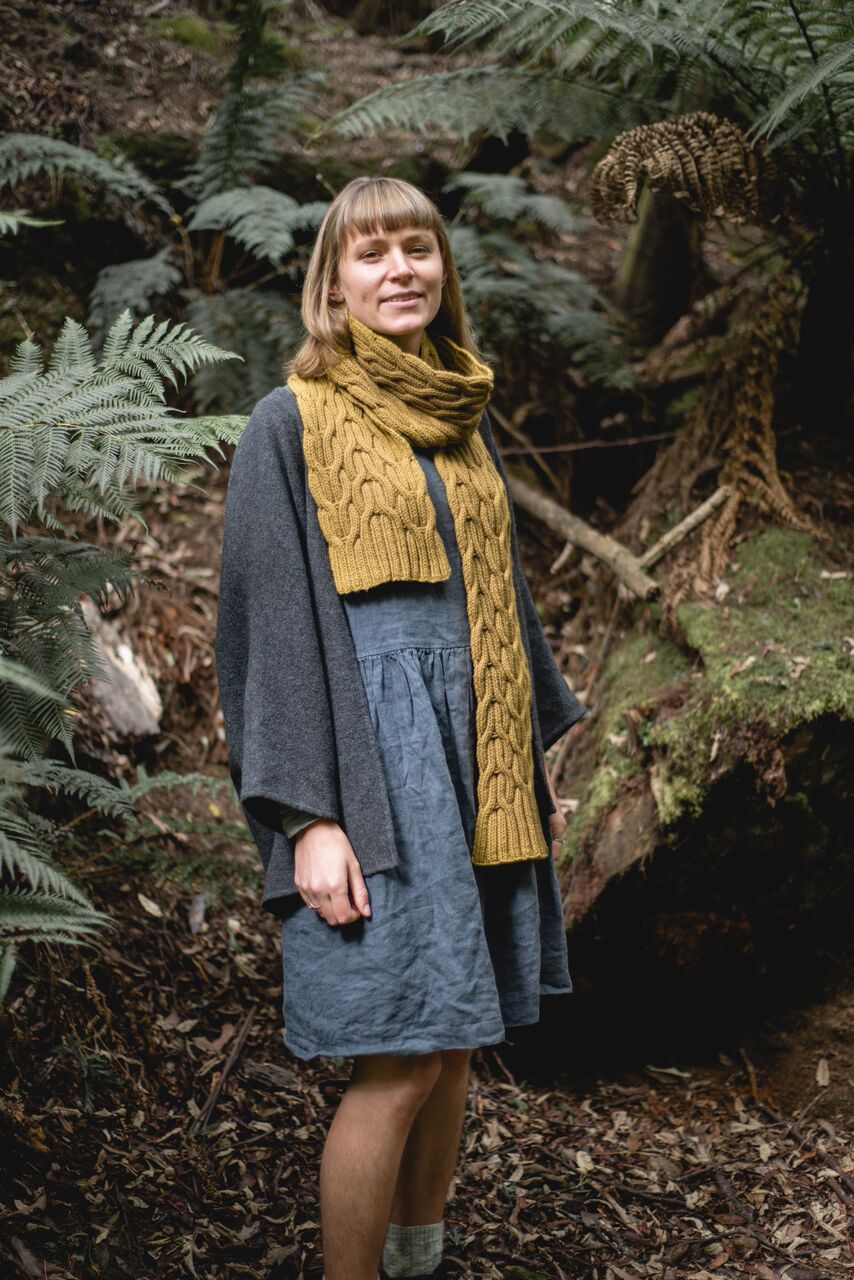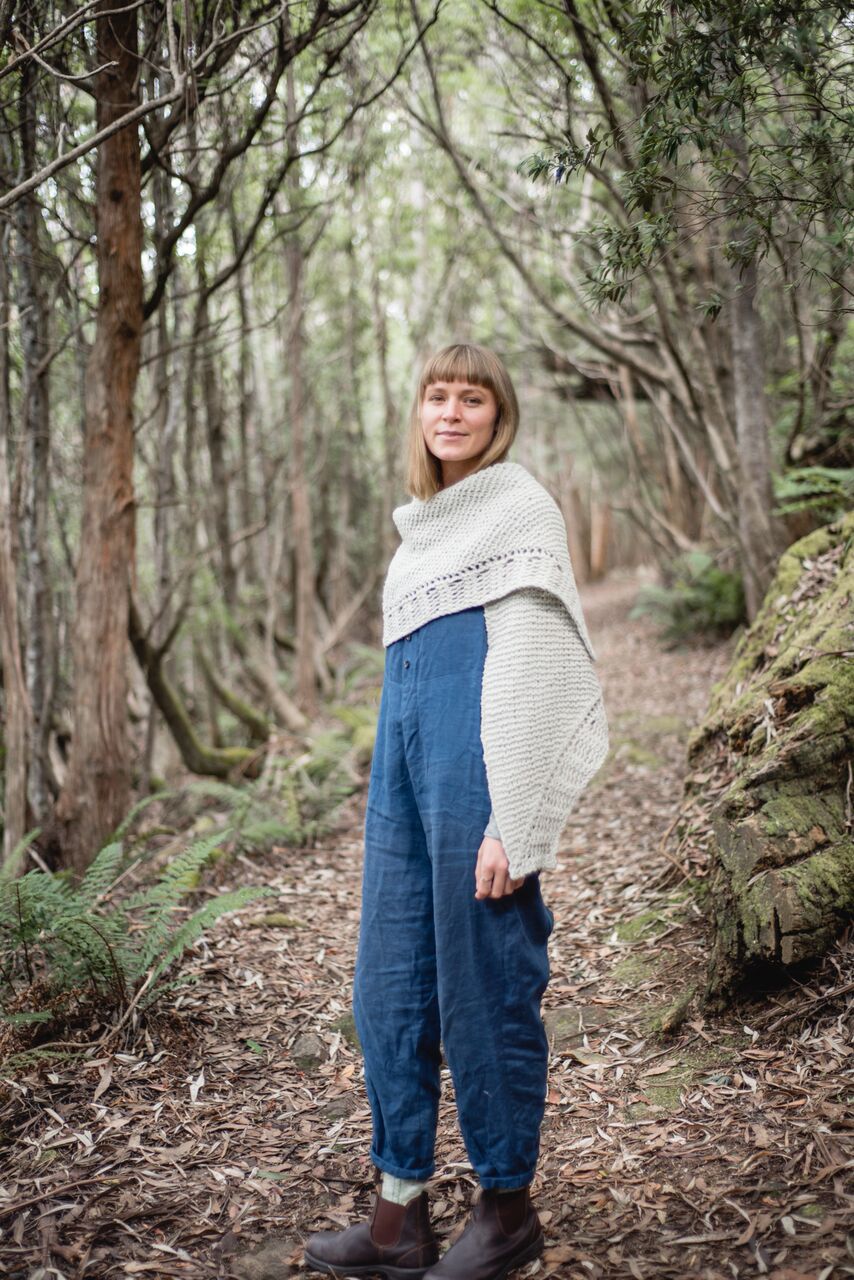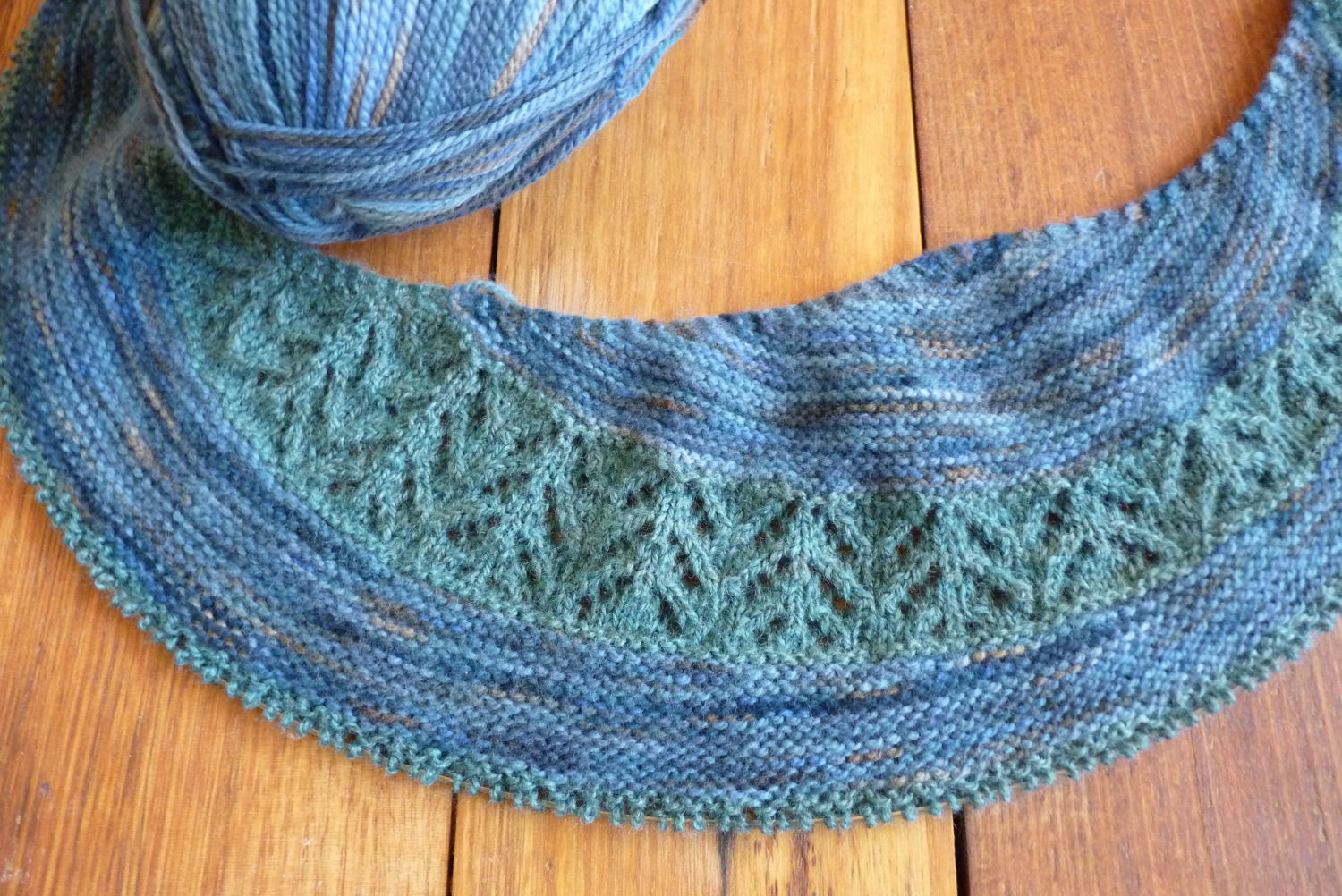
Wrapped
From socks, mitts and hats to keep your extremities cosy, garments to warm your core, and a blanket perfect for a baby, the Wrapped Collection expands into a generous selection of wraps and shawls. Sustainable, ethical Tasmanian wool meets modern design, dovetailing to bring you a wonderful new collection of patterns to craft with.
The Wrapped Collection: seventeen beautifully crafted patterns from designers in crochet and knitwear. Clean, simple lines and saturated colours combine with the softness of White Gum Wool. Effortlessly wrapping you in warmth, these versatile pieces will carry you through the seasons and become wardrobe staples. From socks, mitts and hats to keep your extremities cosy, garments to warm your core, and a blanket perfect for a baby, the collection expands into a generous selection of wraps and shawls. Sustainable, ethical Tasmanian wool meets modern design, dovetailing to bring you a wonderful new collection of patterns to craft with.
Our Wrapped Collection is filled to the beanie-brim with knit and crochet designs to get your creativity flowing. There’s a shed-load of inspiration here, using our 4ply and 8ply Merino yarn, our 5ply silk/merino blend, reinforced sock yarn and our 12ply bouclé.
Let’s start with a look at the new crochet designs.
Hillocks by Shelley Husband
A long, textured scarf, shown here in Ashmore. This design works well with our variegated colourways, but it will also look great in a solid or heathered yarn. You’ll need: three balls of 8ply.
Flamestone by Naomi Skeat
Eyelets, stripes, and a point-to-point construction make Flamestone a lot of fun to crochet. Colour options are many – Flamestone is modelled here in Flame and Quarrystone. You’ll need: one ball of each colour in 4ply.
Millpond by Shelley Husband
Textured and circular, Millpond is a beautiful crochet blanket that’s great for a baby. But it's a versatile piece suited to many uses. Millpond looks fabulous in our solid colourways. You’ll need: eight balls of 8ply.
Onto the knits!
Dolerite by Jessica Gore
Classic beauty with a modern shape; Dolerite is a gorgeous textured shawl of generous proportions, shown here in Natural. You’ll need: four balls of 8ply.
Safety Cove by Imogen Worden
For the ultimate luxurious wrap, cast on Safety Cove. Seed stitch, scallops and lace combine to form a feminine, drapey wrap that will dress up any outfit. You'll need: four balls of 4ply.
Bass Strait by Kylie Robson
Wear it long or double it over for extra warmth; Bass Strait is a textured, reversible cowl, shown in Quarrystone. You’ll need: two balls of 8ply for your own Bass Strait.
Lorinna by Clare Singline
You'll need: just one ball of our 4ply for this lovely take on the shawlette. It wears like a cowl but looks like a shawl, and the texture will please any knitter.
Marakoopa by Kiri FitzGerald
A two-tone pullover with a scooped hem, Marakoopa is a cosy knit in our 8ply – modelled here in Quarrystone and Flax Lily. Go wild with your colour choices or create a classic wardrobe staple. You’ll need: 3-5 balls of Main Colour, and 2 balls of Contrast Colour.
Oatlands by Alison McCarney
The beanie for every body. Extra warmth from a rolled brim, with stacks of cabley texture, Oatlands looks great with or without a pompom. Seen here in Flax Lily and Natural. You'll need: just one ball of 8ply for each hat - including pompom.
He-Oak by Sarah Crawford
We’re thrilled to have a men’s jumper included in this collection. With a versatile collar, saddle shoulders and great textured ribbing, He-Oak will look great on your nearest bloke! You’ll need: between 5-8 balls of 8ply, depending on size.
Striae by Debra Kinsey
The stitch definition of White Gum Wool 8ply is shown to great effect in this amazing pullover. Seamed for extra structure, Striae is supremely warm and cosy. Modelled in Gum Grey. You'll need: between 5-10 balls depending on size.
Myrtle Ridge by Nichole Lubcke
We all love our silk/merino blend. This beautiful design makes the most of two colours - seen here in Natural and Quarrystone. With an elegant lace border, clever increases and some serious stripes, Myrtle Ridge is a classic half-circular shawl of generous proportions. You'll need: 2 balls of your Main Colour and 1 ball of Contrast.
Flaxen by Brenda Green
Cables, lace and length. Flaxen is a generous, light and elegant wrap shown here in Flax Lily. To create this heirloom piece, you'll need: four balls of 4ply.
Flinders by Kylie Robson
With incredible texture, a great fit and a couple of sizes to choose from, Flinders are shown here in our Storm colourway. Every wardrobe needs a pair of handknit socks. You’ll need: one ball of sock yarn for a pair.
Mountain Berry by Sarah Crawford
Keep your hands warm with the Mountain Berry mitts, modelled in 8ply Flame. Lovely texture and simple construction mean you'll be wanting to make more than one pair. And with five sizes to choose from, you can kit out the whole family. You'll need: one ball of 8ply for a pair.
Aomori by Alison McCarney
The ultimate comfort-wrap, Aomori is a sophisticated piece that is as versatile as it is beautiful. Our sample is shown in the Sedge colourway. Ideal as a small blanket or an oversized scarf, this is a great travel companion. You’ll need: three or four balls of 4ply.
The Fall by Suki Hopgood and Sarah Crawford
The biggest and warmest of hugs, this generous oversized cardigan is like a wardrobe best friend. Shown in Silver Wattle, The Fall won't let you down in the comfort department. You'll need: between 6-9 balls of 12ply Bouclé depending on size.
Find the full collection here.
Join us in the White Gum Wool Ravelry group here for a stitch-along.
Follow the journey at #whitegumwoolwrapped and #wrappedstitchalong and on Instagram @whitegumfieldnotes.
Photography: Lisa Kuilenburg | Location: Huon Valley, Tasmania | Collection Director: Sally Oakley
Models: Suki Hopgood, Sarah Crawford and Andy Crawford
Graphic and web design: Michelle French
Walking Wool
I spent some time at an old farmhouse in the Central Highlands last week, and there was a small group of eleven cautious ewes there. We nodded to each other sagely. I think they could tell I was wearing merino.
Among the recorded stories of Australian history is that of a remarkable woman named Eliza Forlong. Eliza emigrated from Scotland to New South Wales with her husband and two sons, and a plan to farm sheep. Husband John stayed at home to run the business, while Eliza began a tour of Saxony (now part of Germany) to source their flock from among the merinos there. Having studied sheep and wool production in Leipzig, Eliza began her incredible project: walking more than two thousand kilometres across the continent, selecting and purchasing her sheep. She was often by herself, shepherding the flock on foot to the port of Hamburg.
From there, in 1829, Eliza’s son William boarded a ship for New South Wales, along with their flock. This ship visited the port of Hobart Town en route to Sydney. The sheep were so fine that they caught the eye of Tasmanian Governor Arthur, who promptly offered William Forlong 1100 hectares of land if he would settle in Tasmania. It was an offer too tempting to refuse.
By 1831, Eliza and the rest of the family were settled at Kenilworth, just north of Campbell Town in Tasmania’s midlands. The Forlong family didn’t stay long, but when they sold the property in 1835, the saxon merinos stayed. In Campbell Town there is a statue of Eliza bearing this inscription:
Direct descendants of Eliza’s sheep still roam the pastures in the Campbell Town district. They produce some of the world’s finest wool, for which the Midlands of Tasmania has become famous.
Merino sheep are indeed well-established in Tasmania. I spent some time at an old farmhouse in the Central Highlands last week, and there was a small group of eleven cautious ewes there. We nodded to each other sagely. I think they could tell I was wearing merino.
I wonder what goes through the mind of a sheep. Whether they are aware of the great beauty of their environment. Certainly, these eleven were spoiled with a stunning location at the edge of Lake Sorrell.
Whatever passed through ovine consciousness, I was left marvelling again at the strength of Eliza, and others like her. While tending the three fireplaces we needed to keep the farmhouse warm - even in early spring - it was hard to imagine what life had been like for those establishing farms in the 1830s.
And their legacy, while complex, is something I can appreciate.
Much of the detail for this post was gleaned from Evan McHugh’s 2015 book The Shearers: The story of Australia, told from the woolsheds.
If the beanie fits
Here we all were, ready to wave goodbye to winter and throw the windows open for a good dose of early spring hayfever. But late August and early September had other ideas, coldly shirt-fronting our naïve expectations and dropping snow in Canberra, and swathes of the higher altitudes in south-eastern Australia - including the White Gum Wool farm.
Here we all were, ready to wave goodbye to winter and throw the windows open for a good dose of early spring hayfever. But late August and early September had other ideas, coldly shirt-fronting our naïve expectations and dropping snow in Canberra, and swathes of the higher altitudes in south-eastern Australia - including the White Gum Wool farm.
We have certainly had a cold winter this year in Tasmania. This June, my Dad announced a planned trip to Pine Valley and the Labyrinth, which prompted slight panic from me. I did what any knitter would do, and offered him a beanie. A Proper Beanie – made from White Gum Wool, thick enough to really be warm, with a long brim that can be folded over for doubly warm ears.
Enter Alison McCarney’s Form beanie pattern (which featured in our Winter Collection). The She-Oak colourway was perfect for Dad, and I posted it express so that he would have it in time (we live at opposite ends of the island).
Reports came back: Dad declared the hat INCREDIBLY warm. And he is not a man to use capital letters lightly! Road-testing elicited more favourable comments. The White Gum Wool was fit for purpose!
My Dad in his White Gum Wool beanie
Photo: Mick Adams, used with permission
The warmth of wool - isn’t that its most basic quality? Yes. But not all wools are created equal. I have noticed this with my own knitwear as I transition toward more natural fibres and less intensive processing. A general rule of thumb is: the less processed the wool, the more its natural insulating properties are retained.
As we now begin - finally - to feel the change of seasons, I'm looking toward the lighter-weight yarns. The silk/merino 5ply is light and warm, but not as hearty as the 8ply merino. While the 4ply creates a truly feathery, breathable fabric that I can wear year-round in Tasmania.
What about you? Are you as enamoured as I am with woollen fabric's flexibility? Do you change your crafting plans as the seasons transition?
Tic Tactile
This is a story about conscious connection. This is something I’ve observed in the crafting community; and it’s on the rise. We are not only becoming more thoughtful consumers. We also care about provenance, and what it means for the feel of the product we’re using.
Winter brought school holidays for my children, and with it the opportunity to spend some time at the coast in northern Tasmania. We unplugged and took long walks, and I was reminded again of the way kids explore the world.
Our son is seven. Besides running and climbing, I noticed the very physical ways he experienced and recorded his time at the beach. His pockets got filled with shells and she-oak cones, sea glass and stones. He would point to things, touch them, chat about them, ask questions about them, and remark on colours or textures.
Of course, being part of a digital generation, he was also keen to use my camera to take some photos. He chose that means of recording for the rockpool creatures he was less keen to disturb by prodding.
By contrast, our eldest daughter (a newly-minted teen) was talking about her emotional response to being able to climb and walk and see the horizon. And our middle daughter (eleven) chatted about her memories of other such holidays.
The kids, of course, had no concern for the time of day, or planning what to eat or where to be next. They were completely absorbed in the moment; in finding the familiar and marvelling at the novel. They were truly connected to their environment, as well as their responses to it.
This is a story about conscious connection. This is something I’ve observed in the crafting community; and it’s on the rise. We are not only becoming more thoughtful consumers. We also care about provenance, and what it means for the feel of the product we’re using.
As we fill our proverbial pockets with the treasures we find, we aren’t just paying attention to the colours. We observe the feel; the textures, the way a fibre behaves. We are asking questions about where it came from. We are learning about how fibres are grown, how they are processed, and the implications of these treatments. Why does that wool feel different to that wool, and which wool is best for this purpose?
I’m finding this a profoundly satisfying adventure. I enjoy hand-winding a skein into a ball. I love choosing a needle-size and casting on a little swatch. I will measure the gauge before I soak it and leave it to dry, observing the difference that blocking makes to the fabric. And sometimes I will simply pull out skeins and balls of yarn and bundle them together to see what works, dreaming about what they might become. It is not an urgent process, but a slow acquainting.
At the root of it all is the question – what is the story here, and what do I make of it?
Care of White Gum Wool Creatures*
"As with all wool, White Gum Wool is a very breathable creature. This means that it can be taken out again and again, and again, without starting to smell like a Cave Troll. Occasional airing is good. A spot-clean here and there can do wonders. And when it really does need a wash, the process is quite simple."
Superfine Merino yarn is a creature that requires some knowledge and care. In this lesson, I am not referring to the variety of yarn that has been treated to become machine washable. Rather, to the “lesser domesticated” species of Merino yarn that remains in its more natural state.
Take, for example, this fine specimen of White Gum Wool. As you can see, it is exceptionally soft. And if you know anything about this sort of creature, you’d be aware that the softer ones do tend to pill more. This is nothing to be concerned about. You will simply need some equipment. I’ve been using a Classic 50 Shaver from the Fabric Care Company on all my creatures for years, with excellent results.
As with all wool, White Gum Wool is a very breathable creature. This means that it can be taken out again and again, and again, without starting to smell like a Cave Troll. Occasional airing is good. A spot-clean here and there can do wonders. And when it really does need a wash, the process is quite simple.
When giving your White Gum Wool creature a bath, do remember not to agitate it. On no account put it in the washing machine, as this could cause it to spook! Simply fill a basin with tepid water, and a good quality wool wash. I like to use Eucalan because I don’t have to fuss about rinsing it out. I put my White Gum Wool in to soak for a half hour or so, then lift it and gently press some water out. I have a clean towel or two at the ready, and I place my White Gum Wool creature on the towel, rolling it and gently treading the excess water out, without wringing. My White Gum Wool loves to dry flat out (like a dragon drinking) in the shade.
Injuries can occur. But the wonderful thing about White Gum Wool is that it heals darned well. I have had some success with the Swiss darning (or duplicate stitch) method for thinner patches as well as holes.
Don’t make the mistake of thinking that your White Gum Wool creature is a pedigree wimp that will cause problems and arc up at the first sign of a neighbourhood cat. The White Gum Wool temperament is placid and loyal. You can expect many years of companionship from your White Gum Wool creatures. You will find that other people love to pat them too, due to the soft pelt.
In summary, White Gum Wool is a very worthwhile companion, particularly suited to those who understand the value of a long-term investment. And those who enjoy a good cuddle.
*with apologies to J.K. Rowling
White Gum Wool 2017 Winter Collection
We bring you warmth. A dozen designs, to cover you from head to toe in White Gum Wool. Knitted in a selection of signature White Gum Wool colours, with the textures of three yarn styles.
We bring you warmth. A dozen designs, to cover you from head to toe in White Gum Wool. Knitted in a selection of signature White Gum Wool colours, with the textures of three yarn styles.
Our 2017 Winter Collection is comprised of eleven favourites and one brand-new design, from designers in Australia, New Zealand and the USA.
Burwood socks from Brenda Green are pictured in our 4ply sock yarn in the ‘Silver Tussock’ colourway. Suitable for those who would like to try their hand at sock-knitting, Burwood has an engaging stitch pattern that will also suit experienced sock-knitters. With four sizes, Burwood will fit most feet, and White Gum Wool sock yarn is now available in four colourways – two multis and two solid colours. Treat your feet to some White Gum Wool socks and you won’t look back.
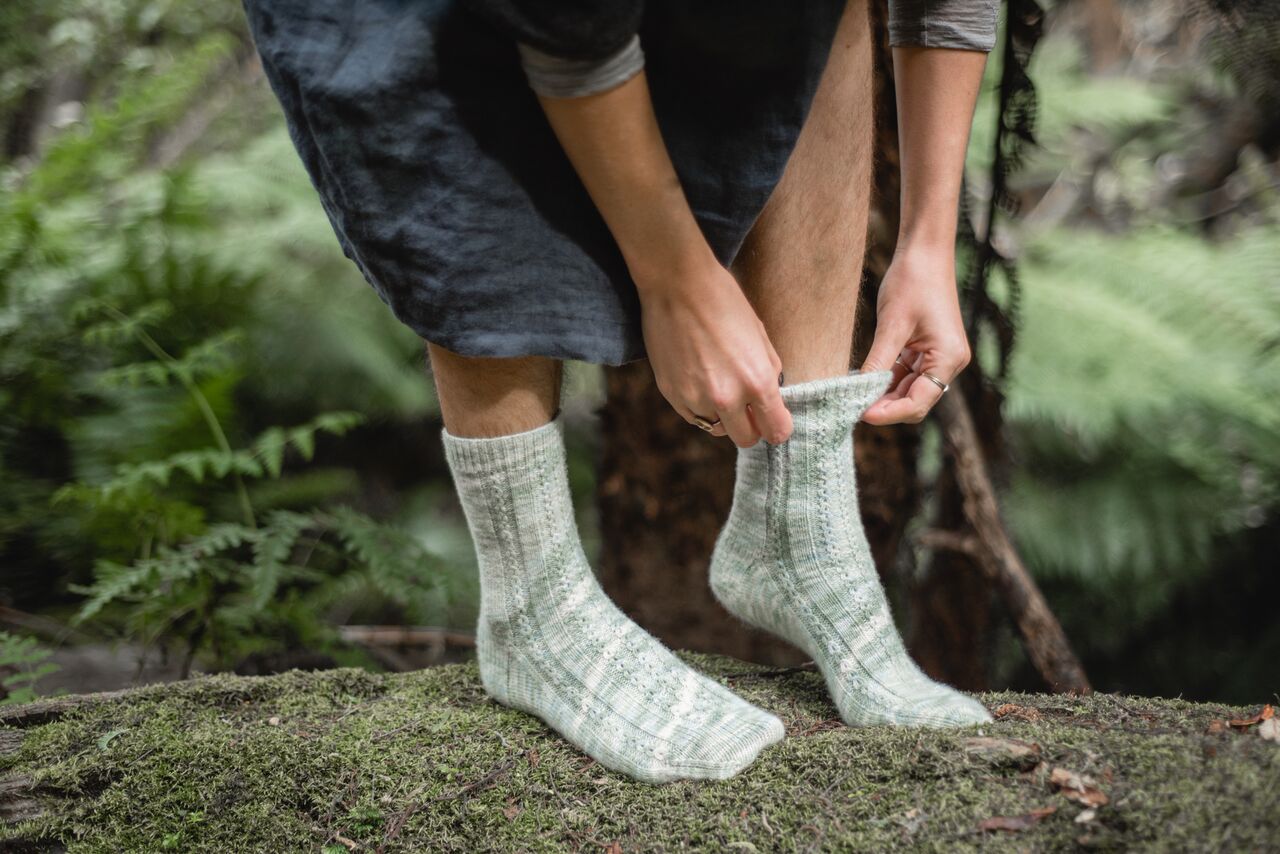
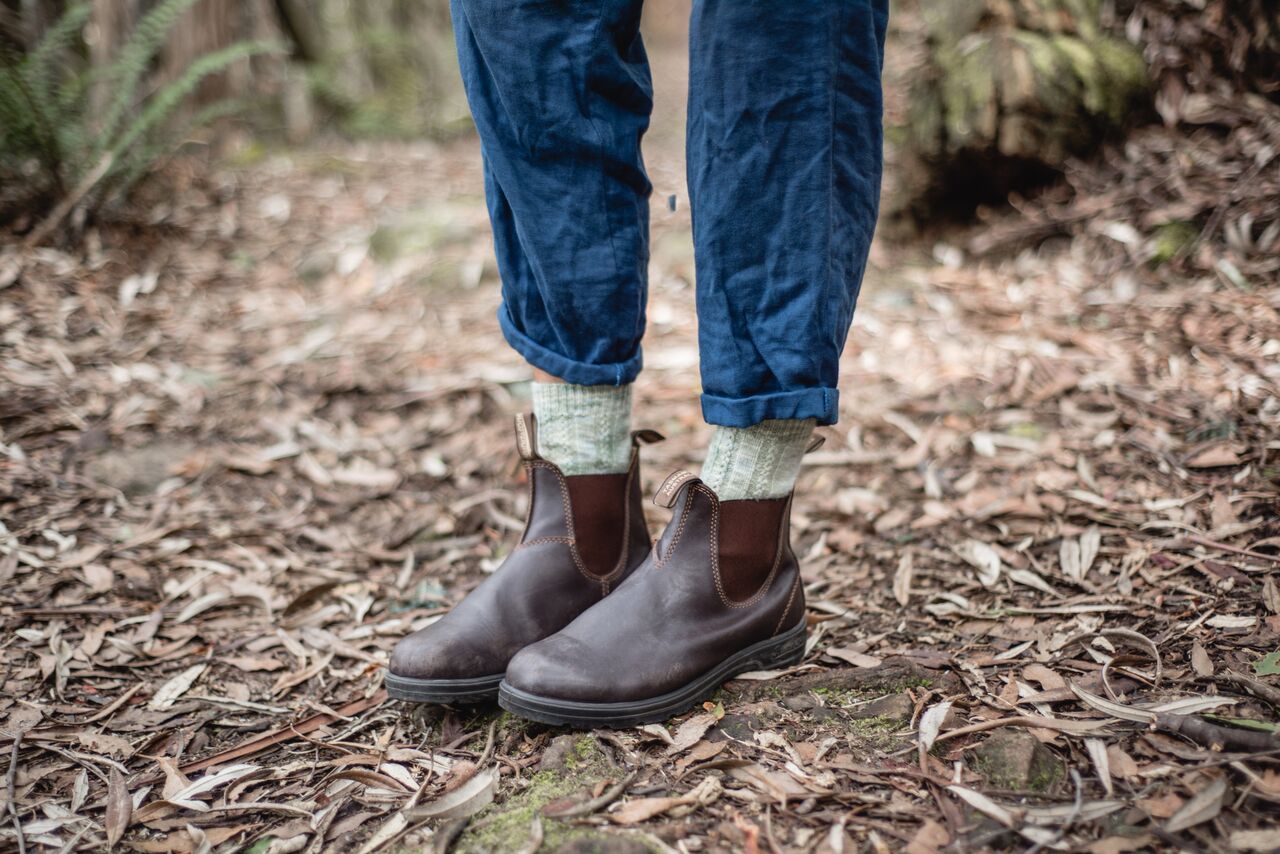
For those wanting fine mitts to take the frosty edge off, we love Nichole Westin's wonderful Inverto pattern. Knitted in our Gum Grey 4ply yarn, Inverto feature a sweet lace detail and well-proportioned thumb gussets. While it may seem like there could be a lot of purling involved, the genius of Inverto is that they’re knitted inside out! The ultimate light fingerless glove.
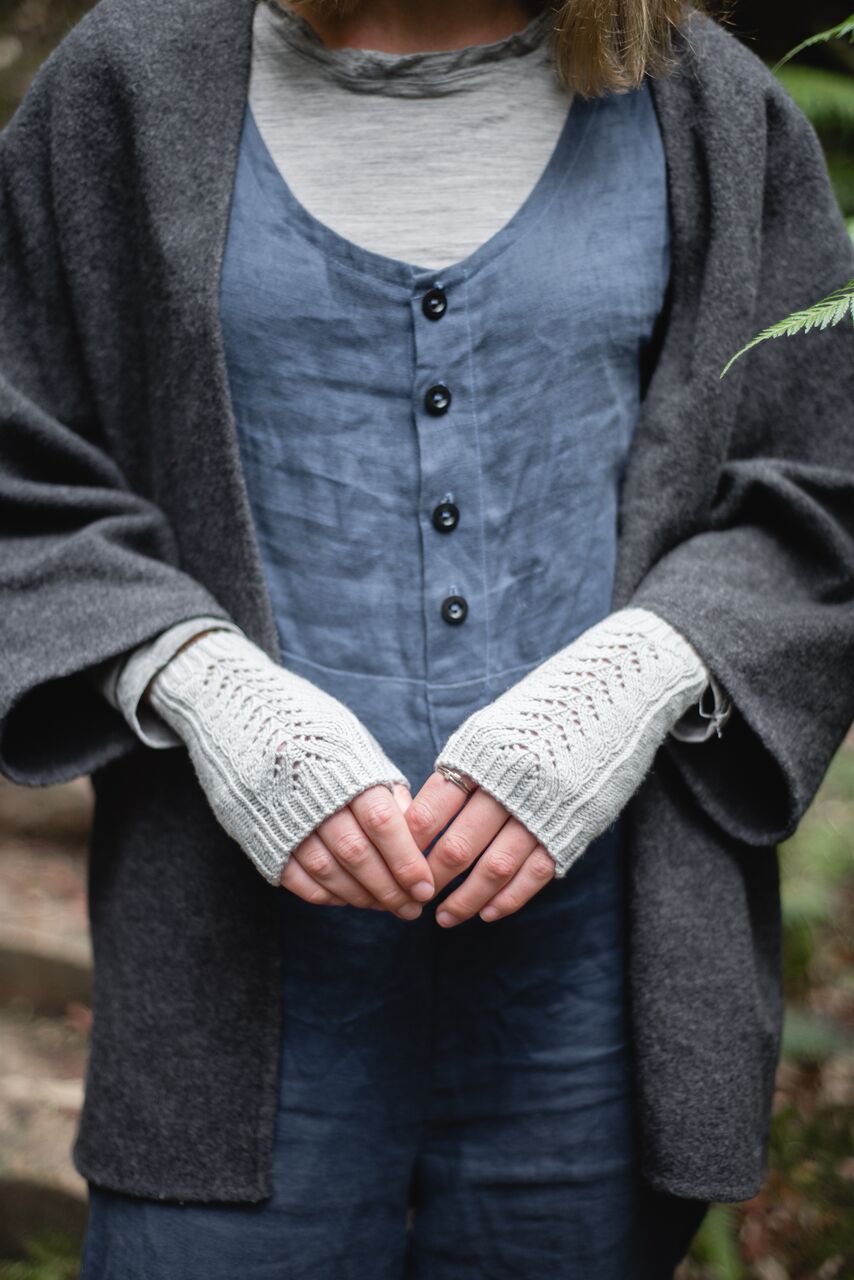
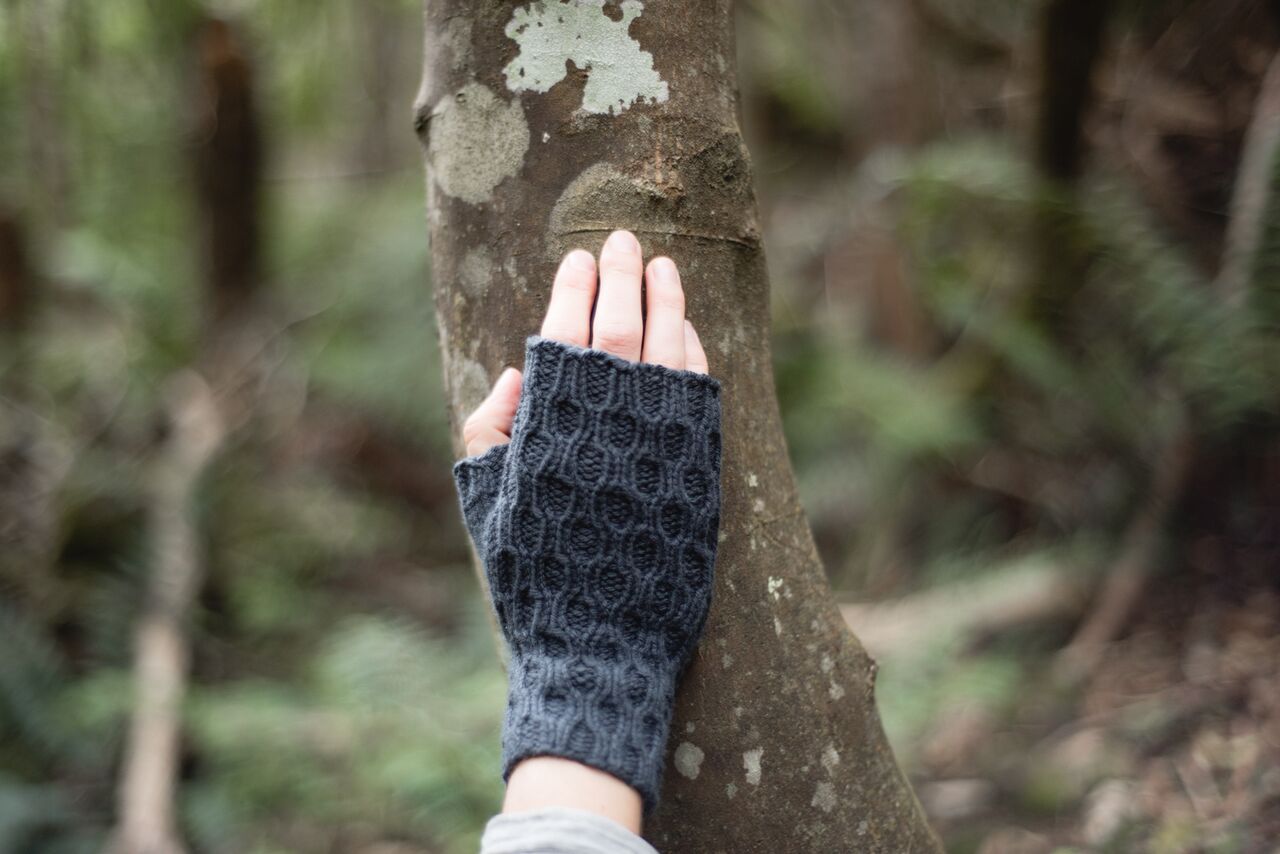
Our 8ply yarn in the Quarrystone colourway is seen here in a pair of Coop Mitts by Justine Turner. With a textured unisex mesh pattern and sizes to fit most people from teens to burly men, Coop Mitts offer real warmth and look great in light as well as dark colours.
Form by Alison McCarney is a modern classic beanie that provides ultimate levels of warmth in our cosy 8ply. Shown here in the new heathered colourway ‘She Oak’, and in ‘Flame’, Form will fit everyone from toddlers to adults. The pompom is optional, of course, but fairly irresistible!
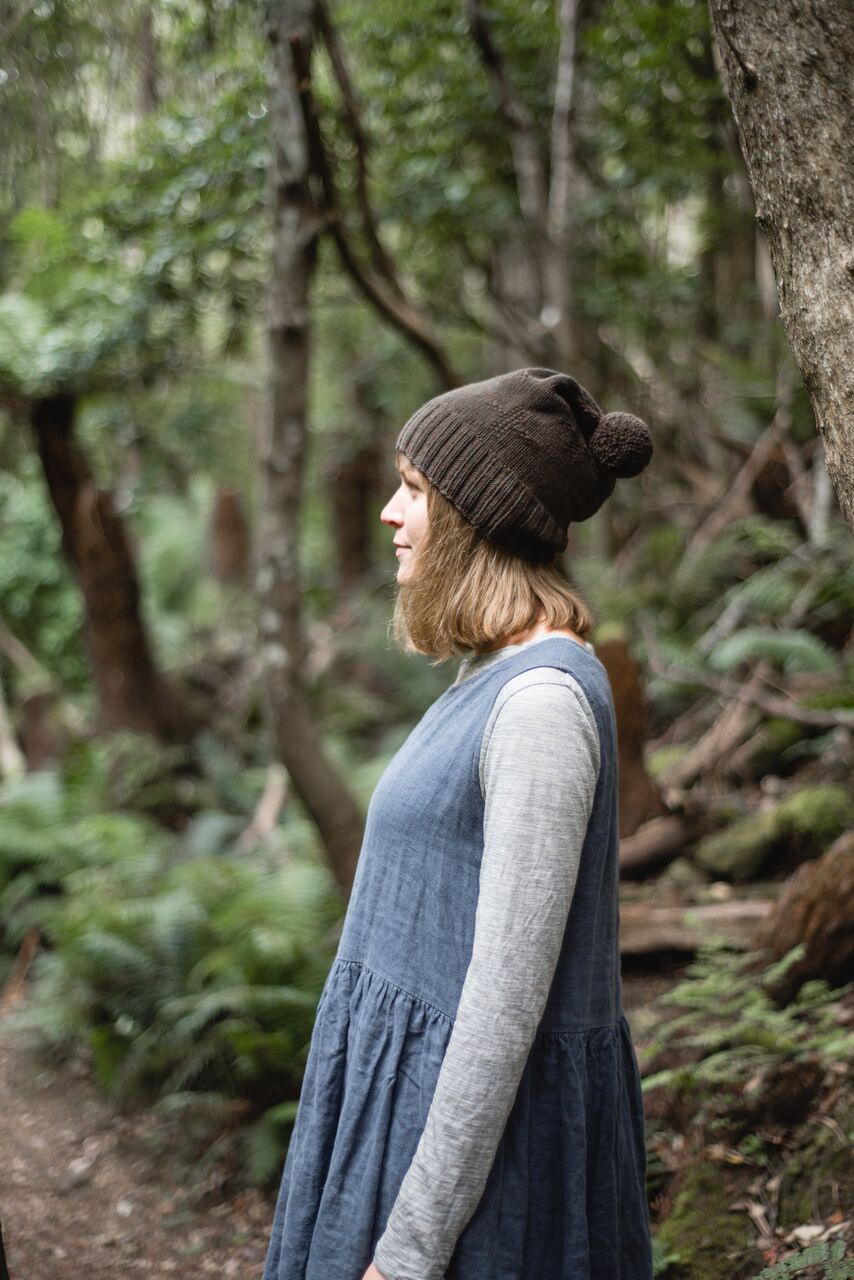
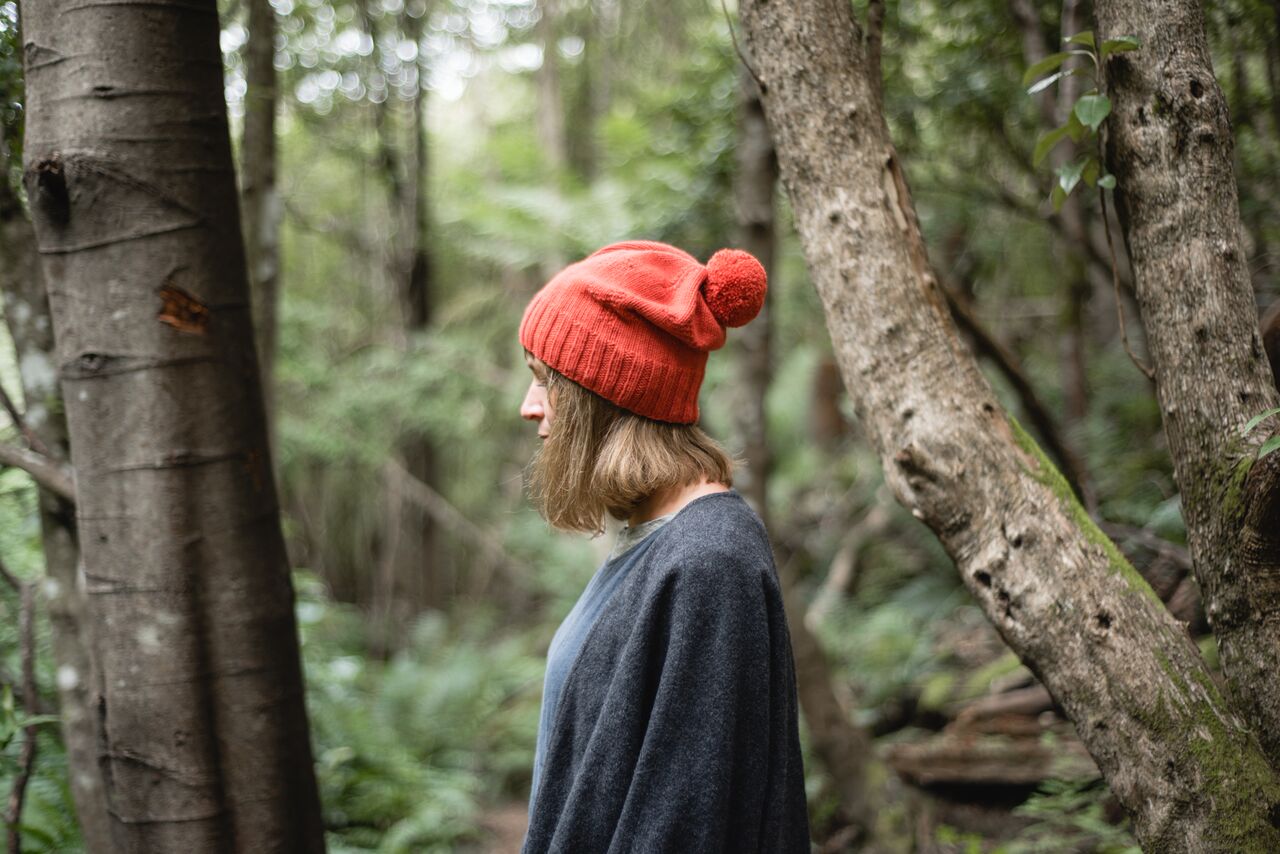
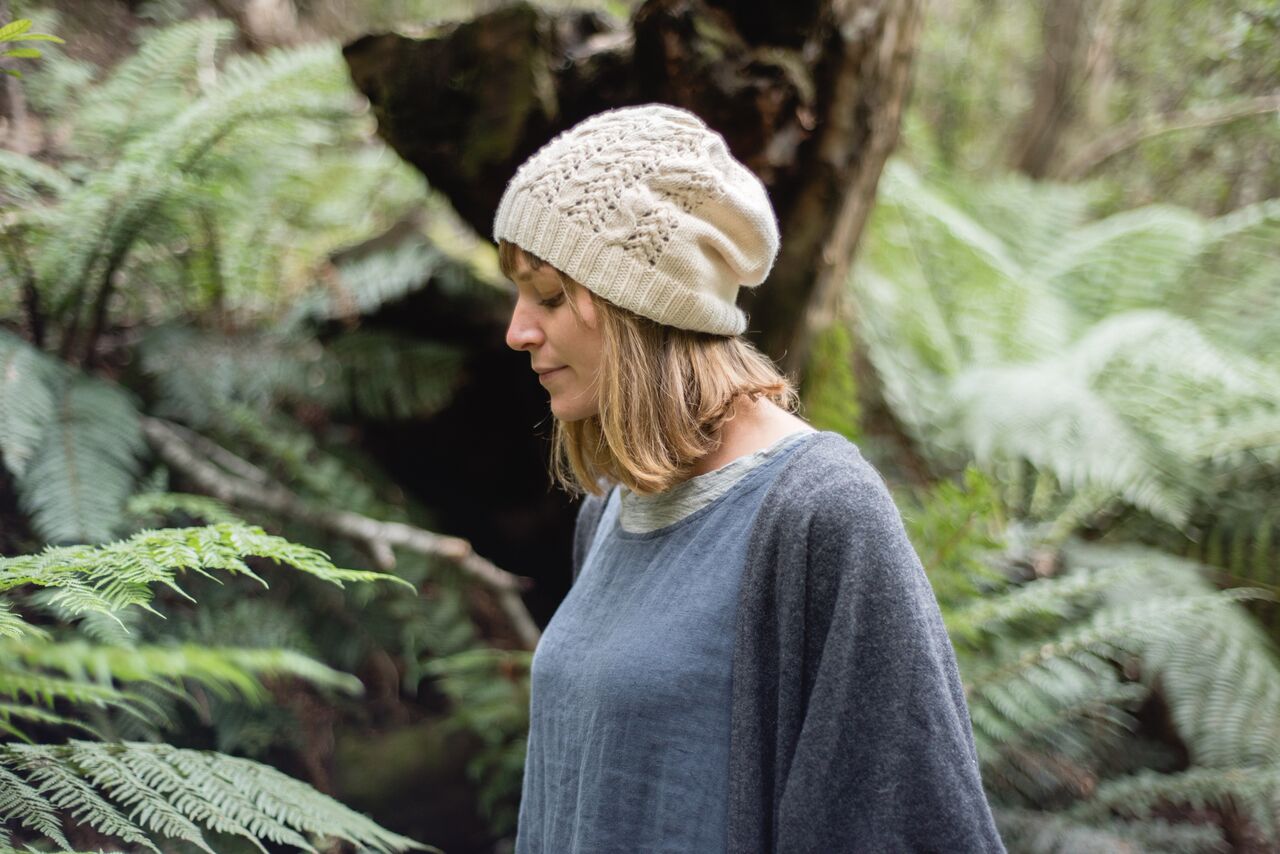
Sally Oakley contributes Tea Breeze. A combination of cables and lace decorate this hat, knitted in our 5ply silk/merino. Pictured here in the natural colour, Tea Breeze presents an opportunity to sample one of our eight silk/merino colourways – including six new colours.
Melissa Schaschwary has written a wonderful sweater pattern in Key To Comfort. Knitted in the 5ply silk/merino and modelled here in the Hawthorn colourway, Key to Comfort really is the ultimate luxury pullover. And best of all: it knits up fast.
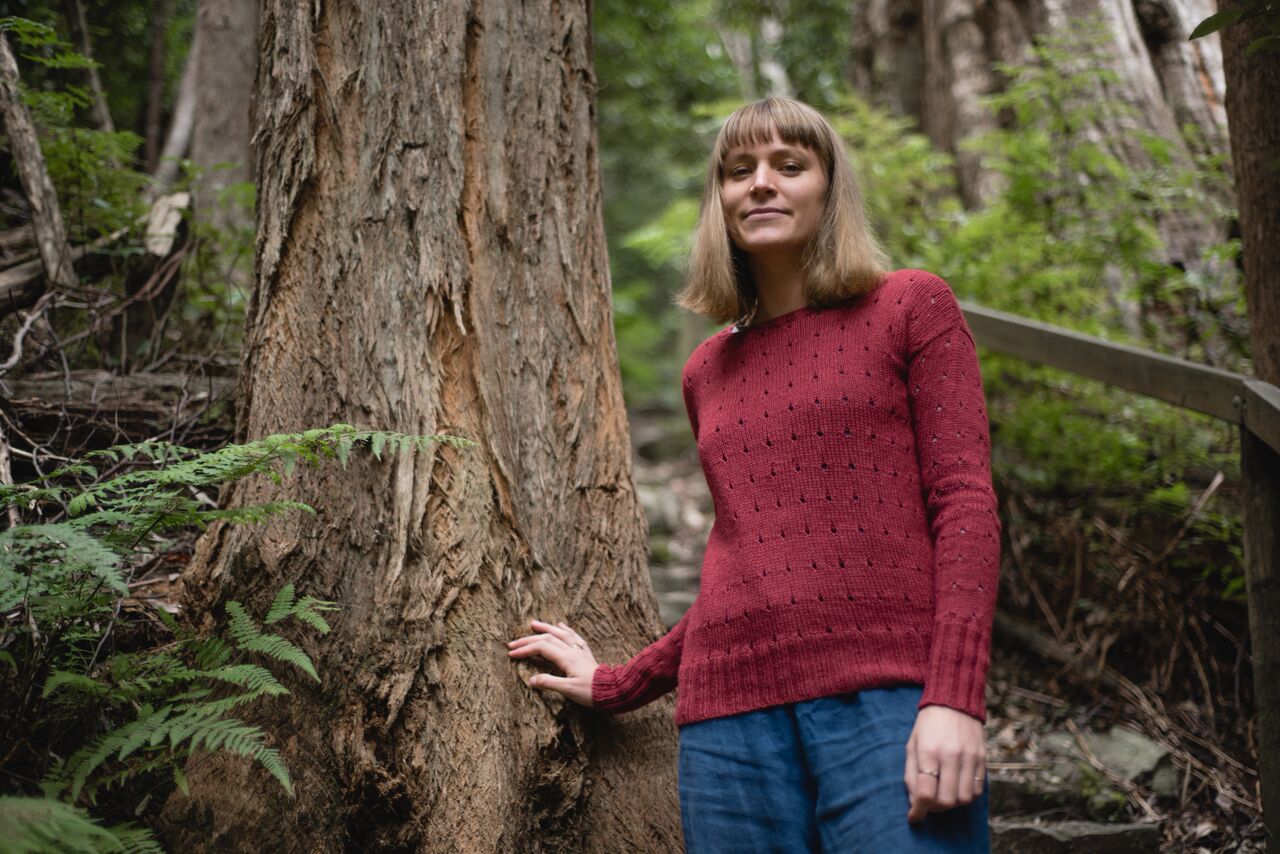
No winter collection would be complete without a cowl or two. Rebecca Robinson contributes her Boobook Trail cowl, knitted in our plush boucle yarn. Our sample is in the Fairy Wren colourway, but the boucle is now available in eight colours. And because Boobook Trail is knitted holding two strands together, the colour play possibilities are many.
Georgie Nicholson designed Uwland (pronounced “You-land”) with three sizes to suit children and adults alike. We knitted ours in the ‘Wild Orchid’ colourway, but our 8ply range now incorporates seventeen colourways – so many possibilities.
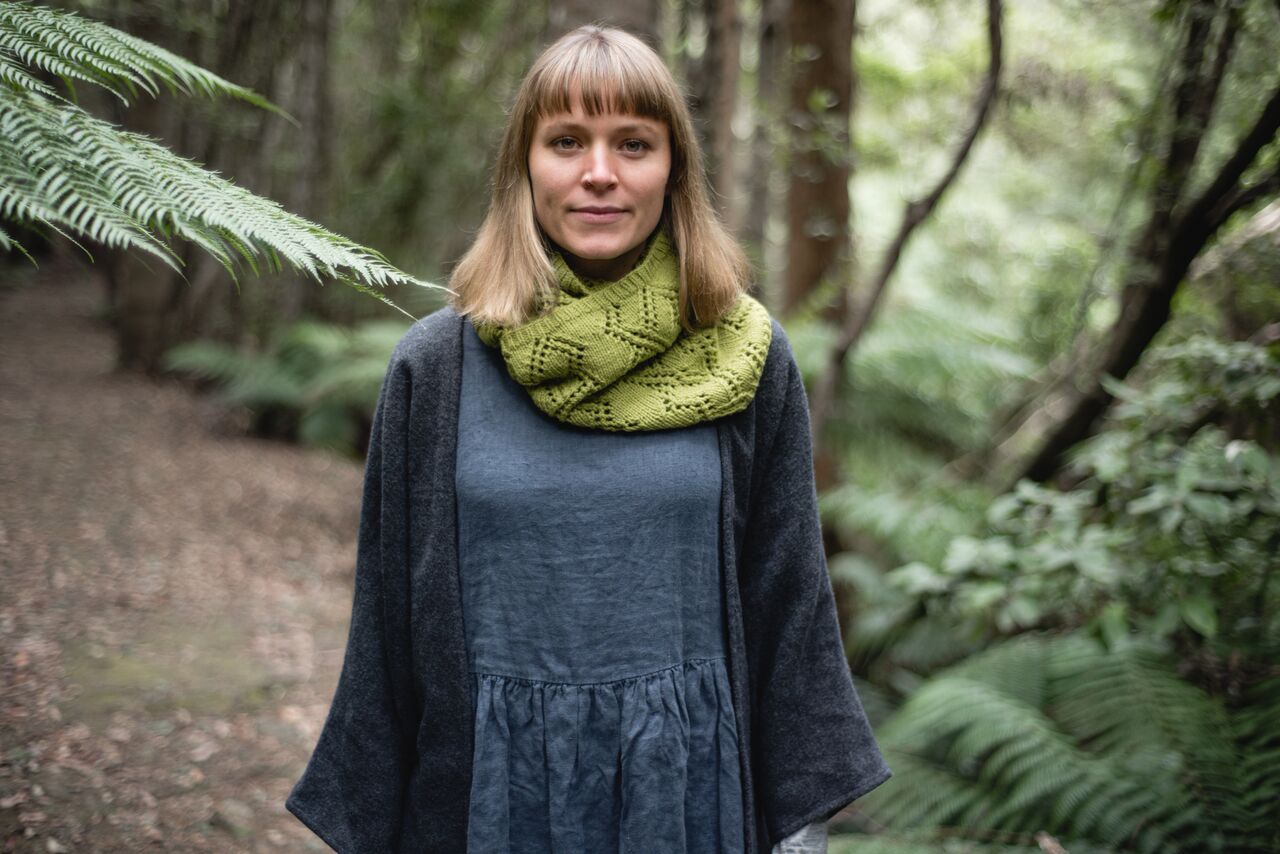
Sandy Holdaway has designed our brand-new scarf pattern. Overleaf is a completely reversible cabled scarf of generous proportions and we absolutely love it. Seen here in our ‘Sedge’ colourway, Overleaf will suit men and women alike. We can see this scarf becoming another modern classic, and look forward to seeing it in more colours!
There is a reason shawls have made a comeback in recent years; not only are they fun to knit, they are practical and beautiful to wear.
Thornberry by Sally Oakley is an asymmetrical triangle shawl with bands of stocking stitch and garter, and a little lace. Knitted at a loose gauge in our 5ply silk/merino, Thornberry is seen here in the natural and Hawthorn colourways.
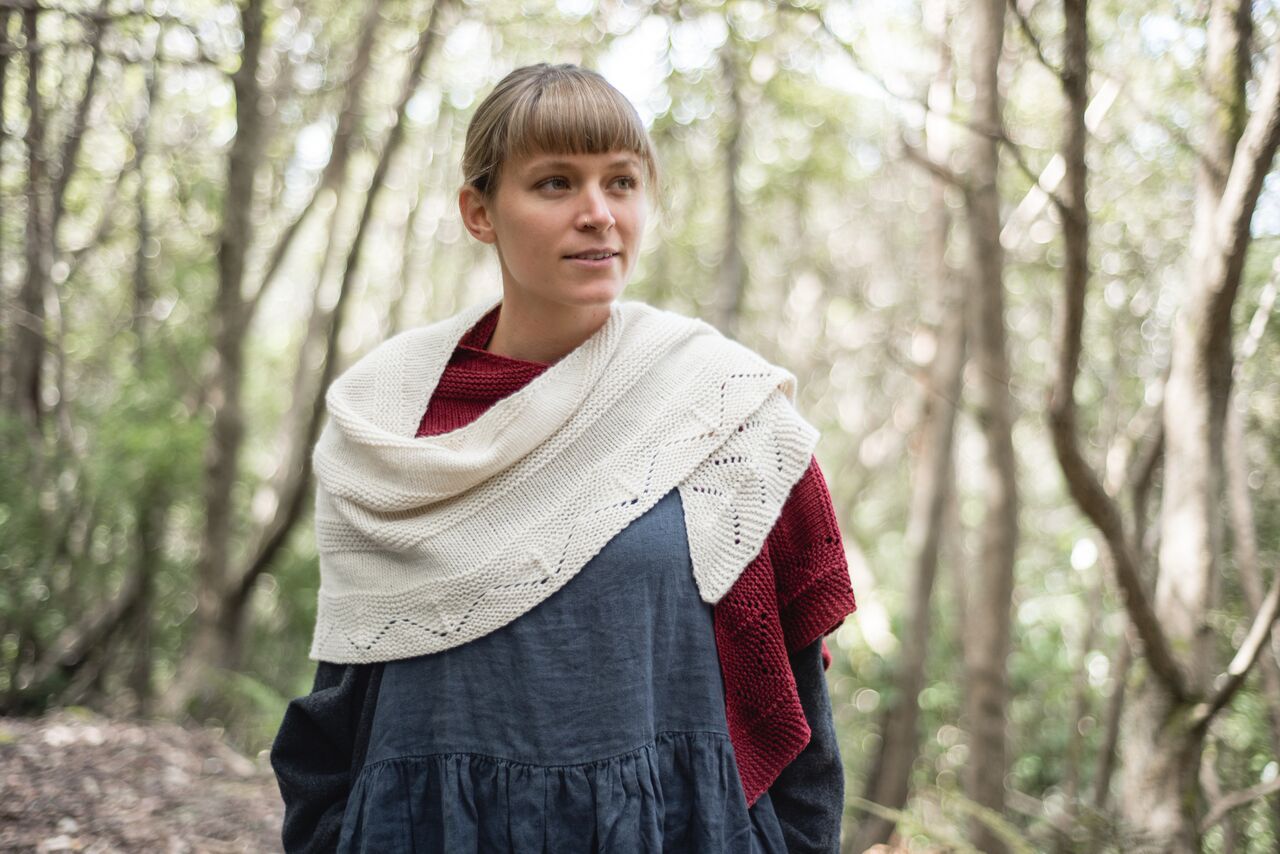
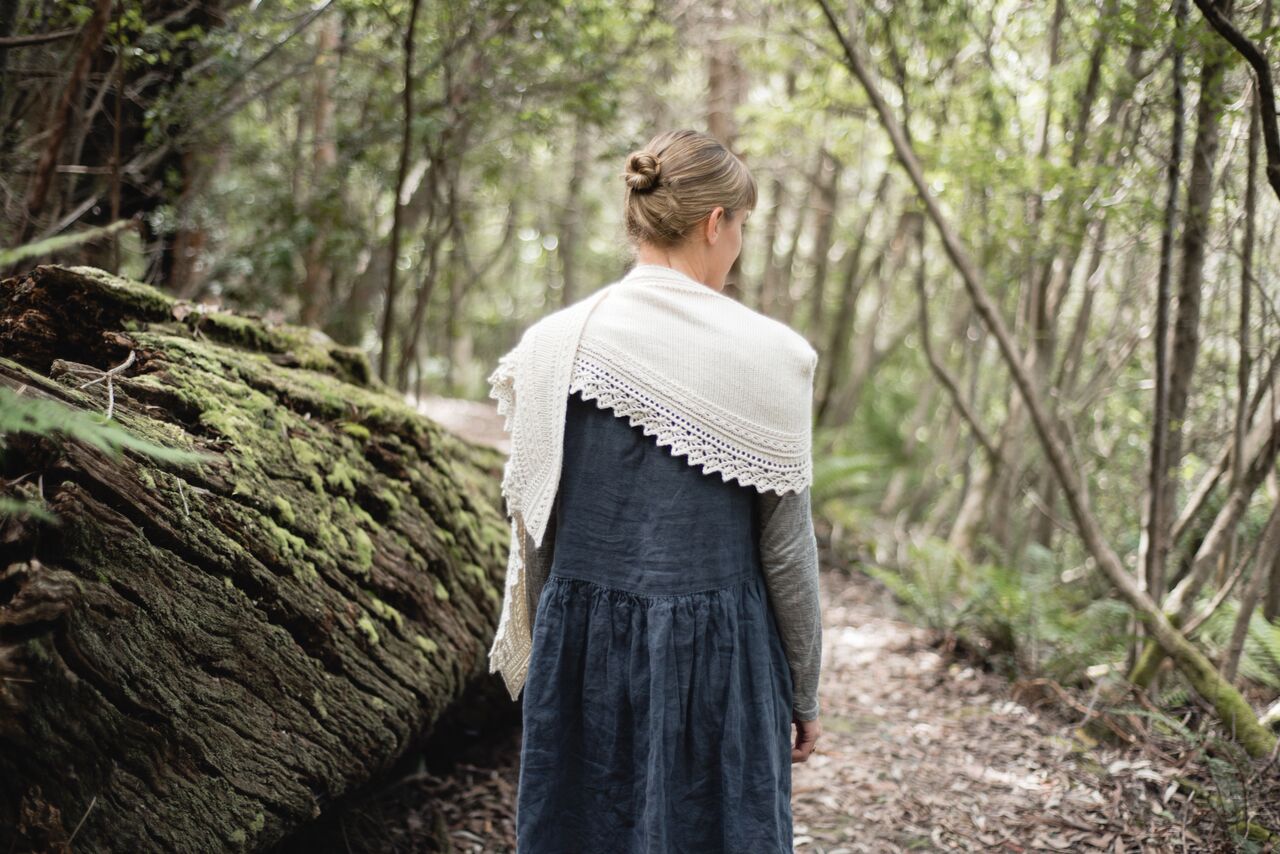
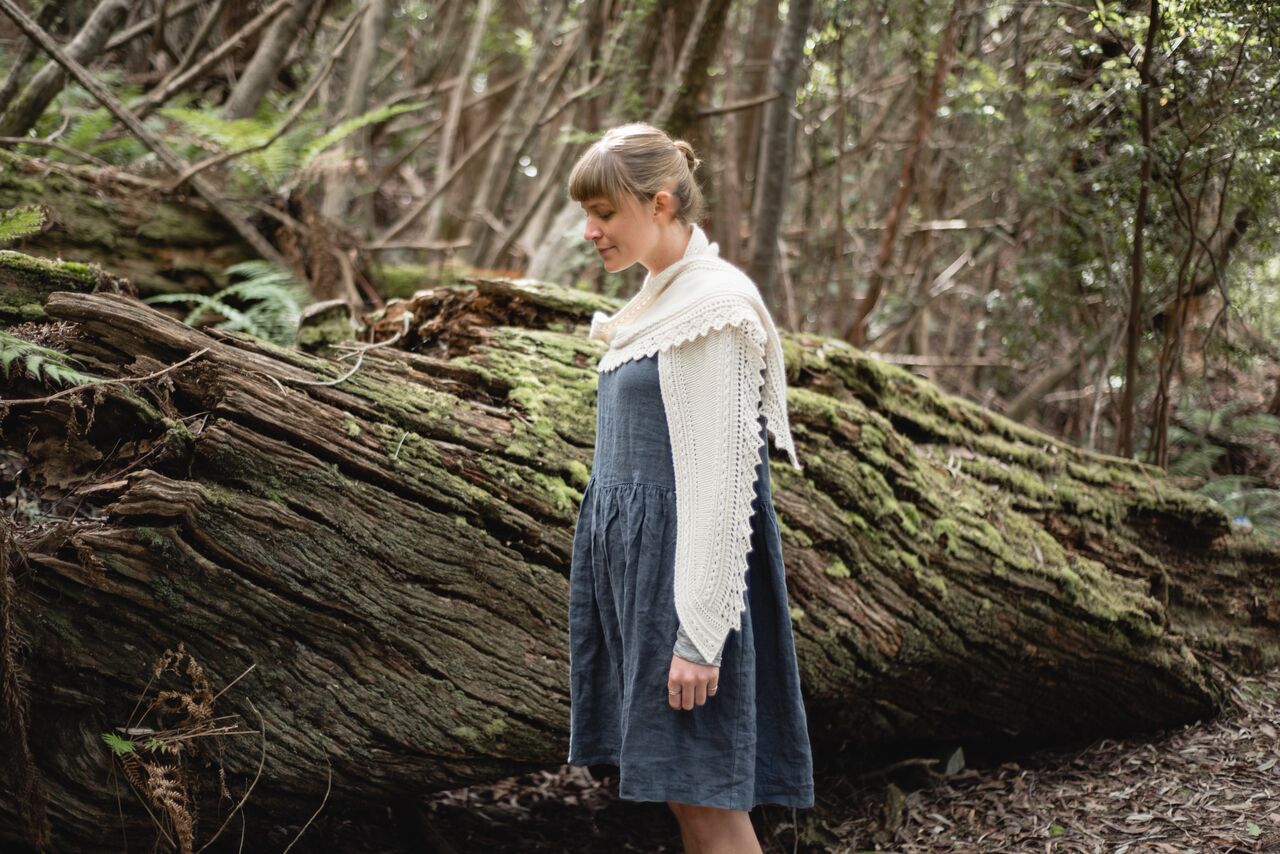
Oolong, by Georgie Nicholson is a delightful, surprising knit. With an interesting and engaging construction (a bit of a Tikki trademark!), Oolong is modelled here in the Natural colour of our silk/merino 5ply. A long crescent shape makes Oolong easy to wear.
Finally, Kelly Brooker contributes a beauty of a design in the Homely Shawl. We knitted ours in ‘Gum Grey’ boucle, for the ultimate go-with-everything accessory. Large and soft as a cloud, Homely is the cosiest of shawls.
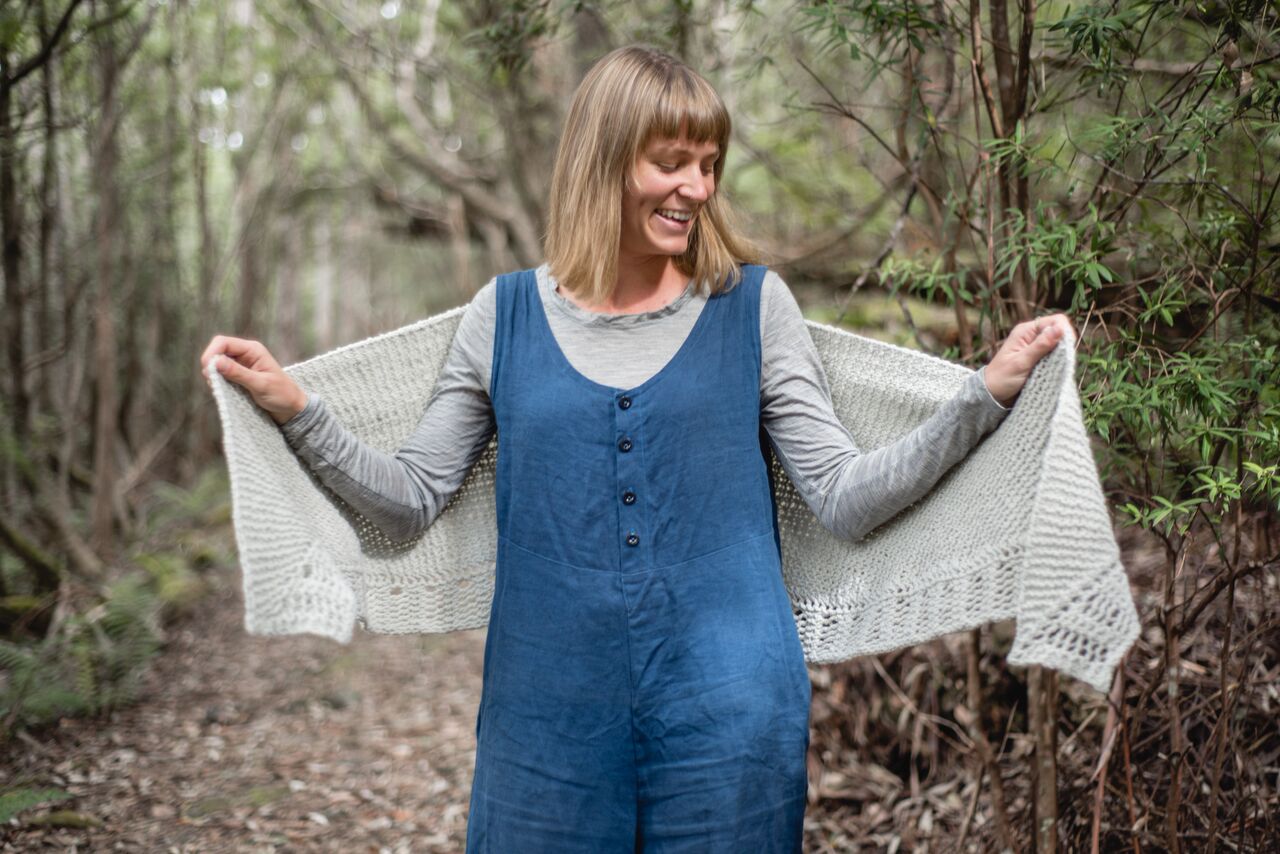
Enjoy browsing our Winter Collection! You'll find it here. Remember that you can choose one free pattern with each yarn purchase. Have fun with colour choices, and dream of cosy warmth.
Location: Fern Tree, Tasmania
Our heartfelt gratitude goes
to photographer Candice Carlin
to model Ani Lee of CloseKnit
to Michelle French and Betsy Baker of French Baker Design + Creative
to sample knitters Alison McCarney, Emma Gregory, Rebecca Robinson and Sandy Holdaway; and
to our designers
Crafty Manoeuvres
We all know of that moment when we stop, and stare at our hands. When the project we are working on sits malevolent and scrunched, and we have the realisation. The knowledge descends that, suddenly, we are not having fun.
We all know of that moment when we stop, and stare at our hands. When the project we are working on sits malevolent and scrunched, and we have the realisation. The knowledge descends that, suddenly, we are not having fun. As my friend Rachael put it:
Recently my knitting has become a chore. Finishing gifts and WIPs[1] and using old stash…I realised how much my ‘practical’ nature can sap the joy from my making practice.
Sometimes, these moments need to be pushed through, for one reason or another. Maybe it’s a promised gift for someone who would be disappointed not to receive it. Perhaps we feel an obligation to finish what we started. Or there is – heaven forbid! – a deadline to meet.
Aside from plain old-fashioned self-discipline, there are a few creative ways to get through these times. Let’s look at three ideas.
#1 - The Diversion:
Rachael decided to cast on “a big, simple shawl” using some of her own hand-dyed yarn, “just because”. I often use this strategy, and I find that working on something relaxing, that is just for me, just for exploration, refreshes my endeavours.
#2 – The Switch:
Doing something completely different for a time can also help. For me, this often means a trip to the garden. While standing there, aghast at the level of neglect, I often spy something that needs trimming, or fruit that needs picking. We have a rather wonderful bramble of blackberries at the moment, and I took a break yesterday just to unburden its branches. As the bowl of berries filled up, my spirits were similarly refilled.
What if we don’t have time for such diversions? In those cases, I usually suggest
#3 - Concurrent Refreshment:
I sit with my work, and listen to a podcast, or watch a documentary. If the work requires thinking, I keep my pen and notepad nearby, and pause when I need to write something down. In doing this recently, I enjoyed hearing from illustrator Christoph Niemann, who talks of creating “an armour of craft around you” when the going gets tough.
Niemann has this quirky advice for anyone stuck in a creative corner:
Throw in something that you’d usually regret, and that’s usually the most interesting part.
I found that advice refreshing as well as challenging. Related to knitting it made me think of bold colour choices, or playing around with gauge, or knitting something I’m really not sure will work out.
“In the best moments,” Niemann commented, “what happens is that design celebrates the world”. That’s certainly how I feel about knitwear and other fibre craft. And what makes wool a standout material to work with is its warmth.
I have a wonderful husband, who very much struggles with the transition to cooler weather. It’s a wonderful thing for me to be able to design and make things that ease the chill. For him, it provides necessary warmth. For me, a creative outlet and a way of celebrating the changing seasons.
So one final way I would suggest for getting through crafting doldrums, is to come back to your sense of purpose. Why are you making? Who for? Is all joy lost, or can you find a way to reclaim it?
An Ashmore diversion in the form of Justyna Lorkowska's Royal Mile shawl pattern.
Do you have any tried-and-true methods of persisting when your project has stalled?
[1] WIPs = Works in Progress
Crafting Solace
In mid-December, a twelve-year-old girl was climbing some boulders with her friends, as she had done so many times before. It was a warm evening; there was laughter, and a pleasing sense of approaching holidays. Christmas was not far off.
In mid-December, a twelve-year-old girl was climbing some boulders with her friends, as she had done so many times before. It was a warm evening; there was laughter, and a pleasing sense of approaching holidays. Christmas was not far off.
Then she slipped. She fell a long way, landing on rocks.
I was at home that evening, when my phone rang. There were four minutes and forty-four seconds remaining in the episode of Gilmore Girls when I hit pause. The girl who fell was my eldest daughter, and she was badly injured.
What followed is a haze of sleepless nights and hard days. Our summer plans changed dramatically. Seven fractures – one of which required surgery – and a dizzying schedule of medical appointments, left us feeling drained.
Knitting during those eight weeks became difficult. Out of necessity, I had to change the type of knitting I was doing. My design-brain receded to the background, and I oscillated between frantic, distracted knitting, and meditative enjoyment.
My focus was on the textures I could feel running through my hands. I noted the quality of the fibres, the detail of the stitches, and the alchemy of transforming string into fabric. I couldn’t think straight, or make decisions, or organise things beyond the essential. But I could still knit. And I could still take notice.
I knitted at my daughter’s hospital bedside. I knitted at my parents’ house while she was recovering. I was not making huge progress with any of my projects, but it seemed essential to me to stay in touch with them.
More than one friend sent me packages of gorgeous things. Being separated from my stash was a discomfort I didn’t expect to feel! So the arriving parcels of yarn were a boost and a joy.
Knitting was also an asset in the waiting-room settings we found ourselves in over the summer. On one occasion I pulled out a ball of White Gum Wool silk/merino (undyed), and began working on a shawl. Before long, the gentleman opposite me was enquiring, “Is that some of Nan’s wool?” A retired woolgrower, he had good things to say about Nan Bray and her methods. He wanted to feel the yarn, and I gladly passed it to him. The ball went on a little journey around the waiting room, as first his son, and then some other ladies in the room held the yarn. I delighted in the look of softness that passed over all their faces as they touched the fibre. Such a simple interaction helped bring me back to a sense of normality, and I felt grounded in a way I hadn’t felt for some weeks.
My other contribution to healing was to decorate my daughter’s leg cast and crutches. She chose her favourite colours, I spared no expense on yarn, and we both enjoyed brightening up those mundane surfaces. When the cast came off, I even adapted the ‘sock’ to fit over her moonboot. The word ‘OUCH’, stitched onto the sock, made us smile.
Our girl is making a good recovery, and we are both stunned and thankful that her injuries were not worse. I am ever-grateful for knitting, for wool, and for days that open up time to craft, whatever else may be happening in the world.
(spoon by Kabwares & Co)
The woolly tempo
We knit to a slow beat. When we turn our hands to make treasured woollens, we know that it will not be quick work. It is as though we craft in a different time dimension.
Those items that we make also have the potential to mess with time. A piece that has been well crafted from wool can last many generations
We knit to a slow beat. When we turn our hands to make treasured woollens, we know that it will not be quick work. It is as though we craft in a different time dimension.
Those items that we make also have the potential to mess with time. A piece that has been well crafted from wool can last many generations.
I have (and I treasure) a woollen blanket that was crocheted for me by my great-grandmother.
My mum says:
This was the blanket Great Nan crocheted for you – her first great-grandchild, and I wrapped you in this on a cold July day to take you home…I used to love watching my Nan knitting and crocheting – it was a childhood mystery…magical…now I watch you and I’m awed.
I used this same blanket to warm my own babies, and will keep it for my grandchildren. Its value goes beyond sentimentality. It is genuinely warm and useful and I marvel over and over that a lady no longer walking this earth still warms her descendants. I have hopes that the blankets I make during my lifetime will do the same.
Some wonderful crafters have been sharing their treasured heirloom stories with me. Some are custodians for woollen pieces made by elders in their own family. Others have started a new making tradition in their family, taking up the mantle after the older crafting generation have passed away. The birth of a child is often a catalyst for people to begin knitting or crochet, or to take it up again after a long break.
What makes these pieces special is the intent behind the making, even if they are imperfect. A friend shared this story:
My mum knitted this blanket for me as a baby. I used it for my third child (our only winter baby). I especially love where you can see it took her a while to get the lace pattern right!
And there is something wonderfully freeing about the fact that imperfection can be stunningly beautiful and much-loved. The thoughts and the love that are poured into a woolly treasure far outweigh any so-called errors. In fact, the mistakes are often the very thing that we treasure about a piece – that identify that it was made by hand.
The hand-made movement is going strong. There’s a common saying, these days: “Makers gonna make”. It’s true. Not much will stop a maker from making. And even long after we are gone, what we made will persist in fibre and in memory; a love that stretches past time.
Of an island & the wearing of wool
I was born on this island, Tasmania. I haven’t always lived here. But the bulk of my childhood was spent in a bushy suburb of Hobart in the shadow of kunanyi/Mount Wellington. The wind whistling down the valley was referred to as “the freight train” by my parents; it was that loud.
I was born on this island, Tasmania. I haven’t always lived here. But the bulk of my childhood was spent in a bushy suburb of Hobart in the shadow of kunanyi/Mount Wellington. The wind whistling down the valley was referred to as “the freight train” by my parents; it was that loud.
I knew I lived in a cool climate, but I didn’t feel the cold much in those days. Young blood is easily stirred and I was a tree-climbing, rope-swinging adventurer. I had a sister and a brother to spend time with, and the rivulets and bushland gave us space and freedom to explore.
We found a tea towel once, discarded on the ground near the creek. The brand was woven into it – it was a Drymor. The towel became our flag, and we named our little land Drymor. I can’t recall what we did there in much detail. But we got muddy and sometimes wet, and came home with eucalypt air in our lungs and twigs in our hair.
Wool was always there. Our Dad wore it bushwalking. In those days, lightweight merino clothing wasn’t yet developed. I remember some heavy woollen pants, a good old tam o’shanter in reds and greens, thick woollen socks, and some handknits from various family knitters. Mum made lots of things for all of us – including a woollen shirt for Dad. Our beds were blanketed with wool. Although we were small city people, we liked to go walking in wilder areas, and we knew how to keep ourselves warm.
I married a Canberra lad, and we lived for a while in a small inland city in Victoria. When we moved back to Tasmania after eight years living on the mainland, I felt the cold so much more. We had young children and there was an innate feeling that I ought to keep them warm. Our heating bills were a shock. It didn’t take long for me to wise-up and think of better ways to warm us all. A trip to the Waverley Woollen Mills shop saw me investing in Merino wool blankets for all our beds. The difference these beautiful blankets make is extraordinary.
And of course, I knit for warmth too. With the five of us, as well as a large extended family, I can’t keep up with all the knitting I’d like to do. But nothing gives me more pleasure than seeing my knitwear keeping a loved-one warm.
I hope you will come with me on a journey. I want to take a good look at wool. Origins and production will come into it a little. But our main focus will be on what happens after the ball-band is slipped off. What do we make with wool? How do we wear it? What do we love about this incredible natural fibre? I’m passionate about Tasmania, and the wool Nan is producing here is just so stellar – I’d like everyone to experience it!
I’m also very happy to invite your input. If there’s something you’d like to know, leave a comment below. Or you can email me: sallyravels@gmail.com I’d be very happy to do some research about any aspect of woolcraft you’re intrigued by.
Warm wishes,
Sally


